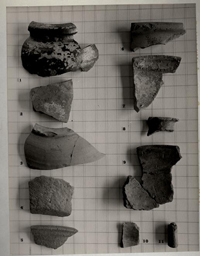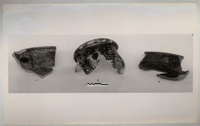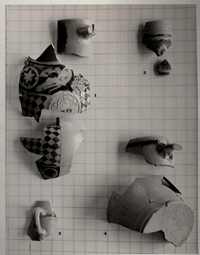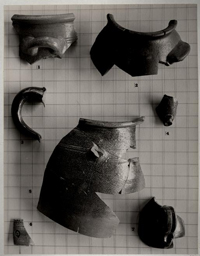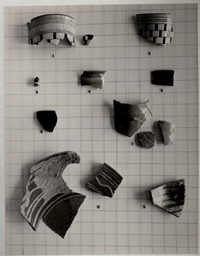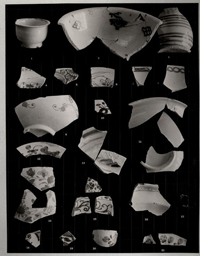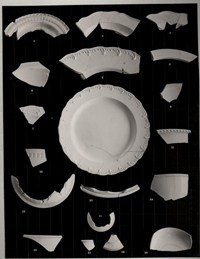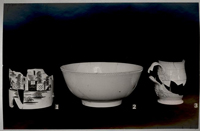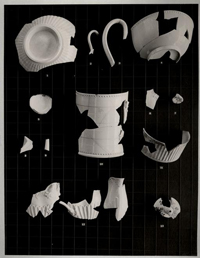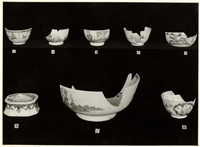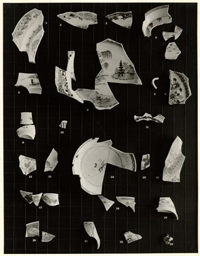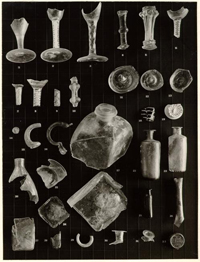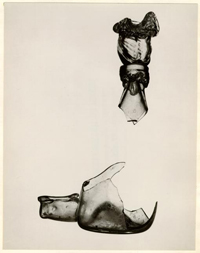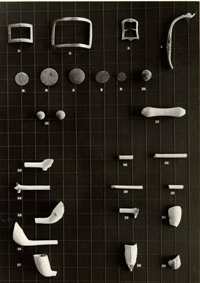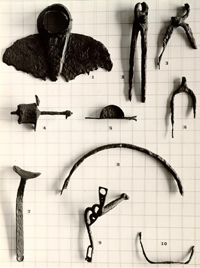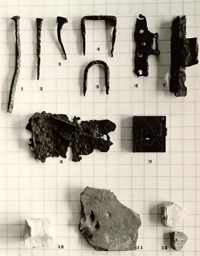Ravensport Site (NB) Archaeological Report, Block 28 Lot 267Originally entitled: "The Ravenscroft Site, Block 28, Area F, Colonial Lot 267 Report on the Artifacts Excavated During 1954"
Colonial Williamsburg Foundation Library Research Report Series - 1557
Colonial Williamsburg Foundation Library
Williamsburg, Virginia
1990
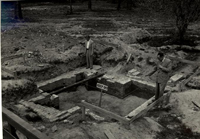 Frontispiece - South-west view of brick structure on Colonial lot 267 after excavation
Frontispiece - South-west view of brick structure on Colonial lot 267 after excavation
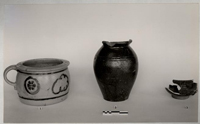 Rhenish brown stoneware and slipware
Rhenish brown stoneware and slipware
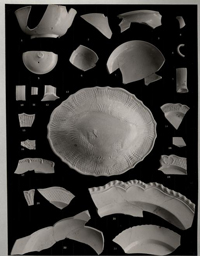 Plate VIII - White saltglaze stoneware
Plate VIII - White saltglaze stoneware
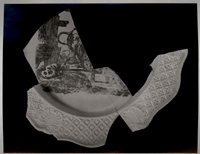 Plate IX - White saltglaze stoneware transfer-printed plate
Plate IX - White saltglaze stoneware transfer-printed plate
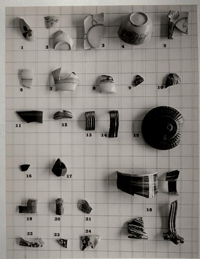 Plate X - Scratch blue, Nottingham brown stoneware, redware, agate and Whieldon-Wedgwood wares
Plate X - Scratch blue, Nottingham brown stoneware, redware, agate and Whieldon-Wedgwood wares
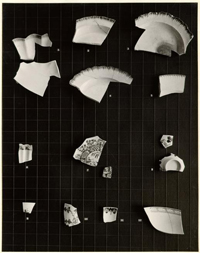 Plate XIV - Pearl ware and English porcelain
Plate XIV - Pearl ware and English porcelain
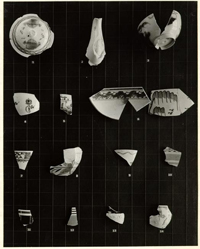 Plate XVII - Hand-painted Staffordshire and 19th century wares
Plate XVII - Hand-painted Staffordshire and 19th century wares
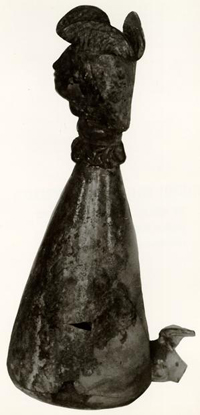 Plate XIXa - Glass bird feeder in Guildhall Museum, London
Plate XIXa - Glass bird feeder in Guildhall Museum, London
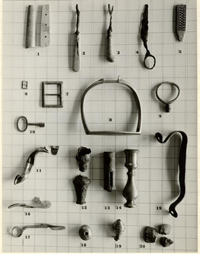 Plate XXI - Cutlery and small finds
Plate XXI - Cutlery and small finds
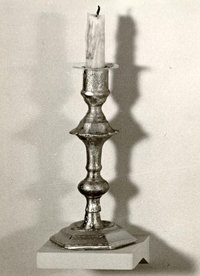 Plate XXII - Brass Candlestick
Plate XXII - Brass Candlestick
THE RAVENSCROFT SITE
Block 28, Area F
Colonial Lot 267REPORT ON THE ARTIFACTS EXCAVATED
DURING 1954
Note
This report was originally prepared by Mr. Robert Mangum Barrow, while working as a student in the Archaeological Laboratory in the summer of 1959. As a conclusion to his training, Mr. Barrow was given the artifacts found in the filling of a cellar from Williamsburg's Colonial Lot 267 and requested to compile a report on the significance of the group as a whole and to describe all the illustrated items.
It was subsequently found that Mr. Barrow was not sufficiently knowledgeable to prepare a report that could be accepted into the Colonial Williamsburg Archaeological Library. Consequently, Audrey Noël Hume, Archaeological Research Associate, was given the task of editing the manuscript and where necessary rewriting it.
September 6, 1962
I.N.H.
TABLE OF CONTENTS
| Table of Illustrations | |
| Introduction | |
| Description of the Artifacts | |
| Ceramics | Plates I - XVII |
| Glass | Plates XVIII - XX |
| Small Finds | Plates XXI - XXIII |
| Iron Objects | Plates XXIV - XXV |
| Appendix I. | Summary of ownership of Colonial Lots 267, 268, 269 |
| Appendix II. | Inventory and Appraisement of the Estate of Joseph Royle, May 1766 |
| Appendix III. | List of marked clay tobacco pipes |
| Appendix IV. | Negative numbers of the plates |
| Appendix V. | Negative numbers of additional photographs of objects from 28F4 |
| Appendix VI. | List of comparable objects from the Ravenscroft site (28F4, Colonial Lot 267) and the Anthony Hay site (28D, Colonial Lots 263, 264, and 265) |
Catalog numbers of the artifacts appear thus [2284-28F4]. The majority of objects appear against a one inch grid; for scale of remainder see text description. All ceramic items are considered to be of English origin unless otherwise stated.
| Frontispiece | South-west view of brick structure on Colonial Lot 267 after excavation | |
| Plate | I | Coarse earthenware and Colono-Indian pottery |
| II | Coarse earthenware | |
| III. | Rhenish and American stoneware | |
| IV | Rhenish, brown stoneware and coarse earthenware | |
| V | Brown stoneware | |
| VI | Slipwares | |
| VII | Delftware and faience | |
| VIII | White saltglazed stoneware | |
| IX | White saltglazed stoneware transfer-printed plate | |
| X | Scratch blue, Nottingham brown stoneware, redware, agate and Whieldon-Wedgwood wares | |
| XI | Creamware | |
| XII | Creamware | |
| XIII | Creamware | |
| XIV | Pearlware and English porcelain | |
| XV | Chinese porcelain | |
| XVI | Chinese porcelain | |
| XVII | Hand-painted pearlware and nineteenth century wares | |
| XVIII | Table and pharmaceutical glass | |
| XIX | Glass bird feeder | |
| XIXa | Glass bird feeder in Guildhall Museum | |
| XX | Beverage bottles | |
| XXI | Cutlery and small finds | |
| XXII | Brass candlestick | |
| XXIII | Small finds and clay pipes | |
| XXIV | Iron objects | |
| XXV | Iron objects and architectural fragments | |
INTRODUCTION
This report is concerned with a group of artifacts recovered from the cellar or basement of a building found on the south end of Colonial Lot 267 on the north side of Nicholson Street in 1954. Unfortunately, no records of the digging survive except for a site plan which shows the building to have been approximately fourteen feet by sixteen feet. Mr. James M. Knight, the field archaeologist, and other members of the Department of Architecture expressed the opinion that the brickwork was of early eighteenth century date. A brief history of the lot will be found in Appendix I of this report, but is of little assistance in interpreting the finds. The Frenchman's Map of 1782 shows a small building, rectangular in shape, with its longest sides parallel to the street in the approximate position of the excavated structure.
While the excavation was in progress, members of the Archaeological Laboratory staff observed that quantities of artifacts were not being collected, and it was suggested that the spoil heaps be sieved. When this was done, fragments obtained by this method were numbered in a different colored ink from the other finds. It is possible, therefore, to ascertain that a high percentage of the artifacts were without stratification of any kind. In the case of the Chinese porcelain, for example, fifty sherds were recovered from the dig and two hundred and eighty-nine from the spoil heap.
This fact has made interpretation of the artifacts extremely hard, but they seem to fall by date of manufacture into three main groups. The more datable and short-lived items such as wine bottles and tobacco pipes are of great assistance in this assessment and form the basis for the following remarks.
The earliest datable objects from the site comprise over 30% of the wine bottle fragments which could have been manufactured no later than 1725 and were perhaps deposited under the cellar floor during the ownership of the lot by Thomas Ravenscroft, Sheriff of James City County (1715-1731). On the other hand, it is possible that they were in an early domestic trash pit filled prior to the building of this structure.
There are virtually only a handful of other objects from the excavation which could have been in use during the first quarter of the eighteenth century. Among them are the blue and white and the polychrome Delft plates (2017-28F4 and 2022-28F4] and the brass candlestick [2210-28F4]. The latter, however, is an object with an extremely long life expectancy. The plates mentioned above were of a type popular in the first quarter of the eighteenth century and of common table varieties, not handsome ornamental pieces which could have survived for some fifty years. It seems likely, therefore, that there was a small quantity of domestic trash associated with the bottles.
Thomas Ravenscroft left Williamsburg in 1723 and moved to a tract of land in Prince George County. However, a mortgage agreement between Dudley Digges and Robert Wills of June 18, 1739, states that the lots had only "lately" been acquired from Thomas Ravenscroft. It is possible that the new tenant improved conditions in the small building on lot 267, and it was at this time that the artifacts from the first quarter of the century were deposited.
Virtually no finds with a short life expectancy from the next quarter century were recovered. However, over 60% of the wine bottle fragments found were of types made between the years 1750-1780, and 6% were the octagonal bottles to which seals of John Greenhow were applied, many of these bearing the date 1770. The amount of ceramics, glass and small finds which could have been in use contemporaneously with these bottles is great and forms the major section of this report. The Greenhow seals prove that the deposition of this domestic trash could hot have occurred before 1770.
In 1763, lot 267, together with lots 266, 268 and 700, was purchased from William Nelson of Yorktown by Joseph Royle, printer, foreman and partner in William Hunter's printing shop, with whom he had occupied a house on lot 268 and whose sister he married. Three years later, Royle's death brought the property into the hands of his elder son William, then about three years old. His mother, Rosanna Royle, was to remain in control of the bequest until the time that the latter came of age, and it seems likely both resided at the house on lot 268. In 1782 the Frenchman's Map shows the building on lot 267 to have been standing. Mrs. Royle disappears from the scene before 1785, by which time her son had come of age, and in that year the main house was said to have been leased to a Mr. Nelson. An examination of the possessions of Joseph Royle listed in his inventory of 1766 shows a number of objects which could be among the collection of artifacts from this trash deposit. Occupation by the same family could account for their presence in a deposit which also contained objects not used in Williamsburg before 1770-1780. To sum up, it seems most likely that the bulk of the artifacts found in this cellar represent a trash deposit made either during the occupancy of the main house by the Royles or by Mr. Nelson. The small collection of nineteenth century artifacts could be explained by the continuing occupation of the site until 1896 when the main house was destroyed by fire.
Detailed examination of the artifacts from lot 267 showed very remarkable parallels with objects found on the Anthony Hay site (lots 264 and 263). Fifteen ceramic objects and six small finds are common to both sites. Both groups represent the domestic possessions of craftsmen of the second half of the eighteenth century, for although Joseph Royle died in 1766 it is unlikely that the taste of his younger son and widow differed too greatly from his own.1
Another reason for the similarity may be in the family connection between the Royles and their neighbors, the Hays to the west and the Davenports to the east. John Holt, who leased the center property in 1745, married Elizabeth, sister of William Hunter II, public printer of Williamsburg about the year 1746, and they lived in the house until 1754 when bankruptcy forced him to leave town. The remaining portion of the lease was taken over by his father-in-law, William Hunter II, who lived in the house. The residence immediately to the east was at this time occupied by another of Hunter's sisters, Mary, who was the second wife of Joseph Davenport, first Town Clerk of Williamsburg and stepmother to Mary and Elizabeth. The latter, by about the year 1757, had married Anthony Hay, cabinet-maker and owner of the shop and residence to the west of Hunter on lots 263 and 264.
William Hunter resided at the property in the center from 1756 until 1761 with his foreman Joseph Royle, who then bought the property outright and married Rosanna, another sister of the deceased Hunter. The death of Joseph Royle in 1766 brought the property into the hands of Rosanna until their son William Royle came, of age about 1784-1785. The date of the death of Rosanna Royle is unknown, but probably occurred before 1785. In that year William Royle advertised the home for sale with vacant possession; and the death of Joseph Davenport in 1761 saw his property pass first to his widow and then to Mathew, Mary Hunter's son, and finally to Mathew's widow until 1800 which marked the end of the Hunter family's association with these three properties.1
Summary
The artifacts described in this report were excavated during 1954 from the cellar or basement of a small structure at the south end of Colonial Lot 267 on Nicholson Street, included in the area known as the Ravenscroft lot. They represent two or perhaps three domestic trash deposits, a small one made in the first three decades of the eighteenth century and a larger one of the period 1770-1785, with the possibility of a third around 1800. The few nineteenth century fragments included would seem to represent surface finds.2
September 1962
A.N.H.
Plate I
COARSE EARTHENWARES
- 1. Rim portion of large jar of coarse, red, ochre-flecked earthenware of Tidewater origin; the lead glaze has fired to dark brown on the exterior and to a lighter shade on the interior. The bulbous body incurves to a collar onto which the rim is folded back in a thick band. Rim diam: 6 ½ ins. Eighteenth century. [1836-28F4].
- 2. Body fragment of large earthenware storage jar (CW type B)1. Traces of white slip on the exterior and of lead glaze on the interior. Eighteenth century. [1837-28F4].
- 3. Rim sherd of hard fired coarse earthenware storage jar (CW type C)2. Internal rim diam: 6 ins. Eighteenth century. [1838-28F4].
- 4. Base sherd of large coarse unglazed earthenware storage jar (CW type c)3, heavily grit-tempered. Flat base and flaring sides. Base diam: 8 ¼ ins. Eighteenth century. [1839-28F4].
- 5. Rim sherd of large round pan of the heavily grit-tempered earthenware produced in the West of England during the Colonial period. The interior is lead glazed up to the heavily undercut rim which is folded back on itself and flattened to form a flat surface on top and exterior. Eighteenth century. [1840-28F4].
- 6. Rim sherd of straight-sided jar of unglazed coarse earthenware with undercut rim which is recessed to take a lid and rolled. External rim diam: 14 ½ ins. Eighteenth century. [1841-28F4].
- 7. Section through pan of coarse earthenware, ochre- flecked and lead-glazed on interior and rim, which is undercut and subsequently folded to produce a concave upper surface. The base is flat and the body shows signs of cutting immediately above it. Other fragments of the same pan indicate that it had a lip to facilitate pouring. Tidewater origin. Internal rim diam: 10 ins. Eighteenth century. [1842-28F4].
COLONO-INDIAN POTTERY
- Rim sherd of bottle or jug of a sand-tempered pinkish ware with rolled rim and exterior red-brown slip. Possibly Indian. Rim diam: approximately 3 ½ ins. [1843-28F4].
- Rim sherd of large straight-sided vessel of sandtempered earthenware, burnished on the exterior, rim crudely square cut. Possibly Indian. [1844-28F4].
- Rim sherd of bowl of sandy-colored earthenware, burnished on both surfaces and with everted and toothed rim. Indian, probably Pamunkey. Eighteenth century. [1845-28F4].
- One cylindrical leg of shell-tempered earthenware, burnished on exterior surfaces and probably from a pipkin of the type found on the adjoining Anthony Hay site (2191-ER243G and ER247G-28D) in a deposit of 1770-1780, but the latter possessed a pronounced exterior leg spine.1 A similar leg is illustrated in Excavations at Rosewell in Gloucester County, Virginia, 1957-1959, Contributions from the Museum of History and Technology, Paper 18, 1962, Plate VI, No. 14, where it was excavated from a domestic trash pit filled about the year 1772. Another such leg was found on the adjoining Anthony Hay site in a deposit made in the first decade of the nineteenth century (2220-ER368-38D). Indian, probably Pamunkey. Eighteenth century. [1846-28F4).
Plate II
COARSE EARTHENWARES (Cont.)
- 1.Section of round pan of ochre-flecked, pinkish, coarse earthenware, lead-glazed on interior and on the rim, which is undercut and then folded back to produce an outward-inclining surface. The base is flat and traces of cutting are present close to its junction with the walls. For portion of a similar pan see Plate I, No. 7. Tidewater origin. Internal rim diam: 14 ins. Eighteenth century. [1847-28F4].
- 2.Rim portion of large bulbous pot of ochre-flecked, buff, coarse earthenware, glazed on all surfaces. The folded rim flares slightly and there are two opposing horizontal handles. The base of this pot (which was not photographed) is flat. Tidewater origin. External rim diam: 7 5/8 ins. Eighteenth century. [1848-28F4].
- 3.Section of round pan of coarse, red earthenware with flat base and rolled rim with single heavy groove on upper surface. Lead-glazed on interior and on rim. Exterior diam: approximately 12 ½ ins.[1849-28F4].
Plate III
RHENISH SALT-GLAZED STONEWARE
- 1.Three portions of a large bulbous jug with multi ribbed neck, manganese-painted except in area of round-sectioned handle, the latter being pierced close to its junction with the rim. The body decoration consists of three horizontal bands; the first and upper zone consists of incised, cobalt-filled designs including a star within a circle, a bird (?), and a series of scrolls. Below this, the widest band is composed of incised diamonds, alternate ones being cobalt-filled. A lower zone (only a small area of which remains) is ornamented with a cobalt-backed scroll-type decoration. The area around the handle is plain, while directly opposite it and in the center of the decorated zones is a sprigged medallion consisting of an ornately crowned G.R. (the letters being cobalt-filled), with two birds on either side of the crown, the whole surrounded by a wreath. A portion of a similar medallion was recovered during excavations on the site of the Moody House on Francis Street. Rhenish. 1740-1780. [1850-28F4].
- 2.Two rim sherds of small cylindrical tankard, plain zone at rim below which are two wide grooves with a cobalt-filled band between them. The central zone consists of incised fern-type cobalt-filled leaves encircling a group of interlocking circles. Neck diam: 3 ¾ ins. Rhenish. Mid-eighteenth century. [1851-28F4].
- 3.Handle and rim portion of small tankard with pronounced vertical chattering and plain rim, below which are two wide grooves with a cobalt band between. The handle has a central rib and a splash of cobalt on one side. Rhenish. Mid- to late-eighteenth century. [1852-28F4).
- 4.Base and neck fragments of large, thick jug with wide mouth, similar to those produced in the nineteenth century by American grey stoneware potters. There is a single groove close to the exterior rim below which is a crudely applied band of cobalt which also encircles the junction of the handle of the body. The base is flat and the body flares from a wide foot ring. Base diam: 5 ¼ ins. Rim diam: 5 ins. Possibly American. Second half of eighteenth century. [1853-28F4].
Plate IV
RHENISH SALT-GLAZED STONEWARE (Cont.)
- 1.Chamberpot with bulbous sides, flat and slightly down-bent rim, rolled on the underside. Below this there are multiple grooves in the middle of which is a broad cobalt-filled band. The main portion of the body is decorated with three six-petaled, incised, cobalt-filled rosettes surrounded by an encircling zig-zag line and finally by a cobalt ring, and two motifs consisting of a sprigged, crowned lion enclosed by a cobalt line. These are arranged alternately, beginning and ending with a rosette and with the lions facing each other. Below this is a zone of grooving and a cobalt band similar to that below the rim. The base is flat and unglazed while the handle has two vertical ribs and its lower end is attached to the body and then folded up on itself. Height: 5 ins. Base diam: 5 7/8 ins. External rim diam: 7 ½ ins. Rhenish. 1750-1775.[1854-28F4].
BROWN SALT-GLAZED STONEWARE
- 2.Tall jar with everted rim, grooved on the interior to take a lid and rounded at top. The body is pear shaped and there are two grooves above point of greatest girth. Considerable signs of wear are apparent on the flat base and whole jar is slipped with iron oxide. Height: 8 1/8 ins. External rim diam: 4 ½ ins. Base diam: 3 ½ ins. Possibly American, second half of eighteenth century. [1855-28F4].
COARSE EARTHENWARE
- 3.Fragment of small bowl of coarse earthenware dipped by the base in a tortoiseshell glaze. The base is flat and the body flares sharply outwards from a rounded foot ring. There is the base of a handle present, possibly of a two-ribbed strap variety. The body incurves slightly toward the top, while the rim flares outwards. Height: 3 1/16 ins. Rim diam: 5 ½ ins. Base diam: 2 ¼ ins. Perhaps Pennsylvania. Eighteenth century. [1856-28F4].
Plate V
BROWN SALT-GLAZED STONEWARE
- 1.Rim fragment of large barrel-shaped jar with everted rim, flattened on the upper surface and recessed on the interior to take a lid. Two inches below the rim a round-sectioned horizontal handle is crudely luted onto the body on top of three girth grooves. Both surfaces are slipped with a ferrugineous clay slip which has burnt on the exterior to a mottled light brown and on the interior is a flat yellow orange. Two similar jars were found in deposits dating between 1760 and 1785 on the adjoining Anthony Hay site (1858-28D and 1859-28D). English (?). 1750-1780. [1857-28F4.].
- 2.Rim, handle and body fragments of large jar of poorly fired red-bodied stoneware with everted rim, flattened on upper surface. Approximately two inches below the latter are two girth grooves on top of which is a short, wide lug handle. The exterior is slipped with a ferrugineous clay slip, the interior is plain. Rim diam: 5 ½ ins. American (?). Late-eighteenth or nineteenth century. [1860-28F4].
- 3.A plain, glossy, rich brown handle from large vessel of uncertain form. Late-eighteenth or nineteenth century. [1861-28F4].
- 4.Body fragment of cylindrical tankard with pink core burnt after breakage in a low-temperature fire. The lower portion is charcoal and has the base of a small strap handle (missing which has been smoothed on the body, and the end folded back on itself. The top of the handle is present and this marks the lower limit of the ferrugineous clay slip which produces the characteristic brown upper section of this class of tankard. Yorktown. 1720-1750. [1862-28F4].
- 5.Portion of rim and body of large, barrel-shaped jar with everted rim, rounded on upper surface. Two inches below the rim are the remains of a round-sectioned, horizontal handle, crudely applied on top of three girth grooves. The body is grey and the upper eight inches of the exterior surface have been dipped in a ferrugineous clay slip to produce the mottled brown effect. External rim diam: 8 ½ ins English. Second half of eighteenth century. [1863-28F4].
- 6.Small, multiple-ringed, neck fragment of jug, in the vertical center of which an oval stamp has been applied producing the raised letters "WR" surmounted by a crown. This is an excise mark of William III, seven of which have been found in Williamsburg, though none from this particular stamp. The use of "WR" does not necessarily mean a date of manufacture between 1688 and 1702, as a tankard 1 dated as late as 1792 bears a mark of this kind.1 English. 1720-1775. [1864-28F4].
- 7.Body fragment of small, bulbous, handled bottle. The thick strap handle was thumb-pressed onto the body and tapered at its end to form a rat-tail. The core is grey and the exterior has been covered with a ferrugineous slip which when fired, produced a rich brown mottled surface. 1720-1770. [1865-28F4].
Plate VI
SLIPWARES
- 1.Portion of tankard with red agate body, covered on exterior surface below rim with a white slip which has been cut through to expose the body in a series of six bands, below which are horizontal bands of chequer pattern, the agate areas being approximately one-quarter the size of the slipped ones. The smaller fragment is the lower portion of the handle which is a red clay (not agate) and whose lower end, after attachment to the body, has been turned upwards on itself and pinched, in the manner of English white salt-glazed jugs and tankards. Rim diam: 4 ½ ins. English, Staffordshire 1740-1760. [2075-28F4].
- 2.Rim sherd of tankard with red agate body covered on the exterior surface below the with a slip which has been cut through to expose the body in a series of three bands, below which are horizontal bands of chequer pattern, the agate areas being half the size of the slipped ones. Rim diam: 4 ins. English, Staffordshire. 174o-176o. [2076-28F4].
- 3.Red-bodied, acorn-shaped knop with clear glaze, from tea- or coffee pot, around the base of which is a trail of white slip. Possibly a product of the pottery of Samuel Bell, who was working in Newcastle-under-Lyme in the period 1730-1752. [2077-28F4].
- 4.Rim sherd of bowl of buff ware, apparently covered with a slip of the same clay and a clear glaze. The rim is extremely everted. English. Eighteenth century. [2078-28F4].
- 5.Rim sherd of bowl of red ware with plain rim and whitish slip on interior beginning a short distance below the rim, and some manganese mixed with the greenish glaze. A bowl of similar ware, though with less manganese, from the Anthony Hay site, was found in deposits pre-dating 1780 (2080-28D). Rim diam: 10 ins. American, perhaps Pennsylvania. Eighteenth century. 1750-1780. [2079-28F4].
- 6.Rim sherd of bowl of red ware covered on interior with a white slip and on both surfaces with a glaze containing manganese, producing a tortoiseshell coloring. For details of other similar bowls see No. 5, also Plate IV, No. 3. American, perhaps Pennsylvania. Eighteenth century, probably 1750-1780. [2081-28F4].
- 7.Shoulder and two body sherds of jug of buff ware, coated on exterior with slip of similar clay and covered with a yellow lead glaze. The purpose of the slip was to allow the application by trailing of bands of a dark brown slip running horizontally around the jug. The lower part of a small strap handle is present. English, Staffordshire or Bristol, eigthteenth century. [2082-28F4].
- 8.Section of sloping-sided round pan of ochre-flecked buff ware, on the inner surface of which a white slip has been trailed in a series of horizontal bands, in the center of which is a wavy line. The base is flat while the rim is flattened on its upper surface. Height: 3 5/8 ins. Diam of base: 9 ins. Diam of rim: 14 ins. American (?). Eighteenth century. [2083-28F4].
- 9.Rim portion of bat-molded dish of red ware with: notched rim and no foot. Trails of a white slip and blotches of copper oxide have been applied to the interior surface which has then been coated with a yellowish lead glaze. American (?). Probably second half of eighteenth century, [2084-28F4].
Plate VII
DELFTWARE
- 1.Ointment pot, the body outcurving from the foot within which the base rises slightly. The rim is everted and there is a circular concavity within the interior of the base. The pot is covered with a bluish-white glaze except for the unglazed base. Height: 2 ins. Rim diam: I; 1/8 ins. English. Eighteenth century. [2003-28F4].
- 2.Section of bowl with everted rim, foot ring and recessed base. The exterior is plain, while on the interior of the bowl are alternate cobalt-painted motif's consisting of a diamond divided into six parallelograms, and a stylized floral spray. There are traces of further decoration of uncertain character in the bottom of the bowl. Fragments of another bowl of similar shape and design are present in this group. Height: 3 ins. Rim diam: 5 ins. Foot diam: 3 ½ ins. English c. 1760. [2004-28F4].
- 3.Section through drug jar, cylindrical in shape but waisted close to base and rim, the latter being everted and square cut. The interior is plain but with pronounced potting rings, while the exterior has nine bands of cobalt-painted lines in two groups of four and five respectively. The foot is undercut and the unglazed base rises slightly. Height: 3 ¾ ins. Ext. rim diam: 4 ½ ins. Ext. foot ring diam: 4 ¼ ins. English. Eighteenth century. [2005-28F4].
- 4.Marly and bowl fragment of deep plate or bowl, plain on exterior and with a decoration close to the wide edge of the marly consisting of a series of dashes enclosed between two concentric lines and separated by vertical lines. In the bowl is another band of decoration, enclosed on the upper edge by one, and on the lower by two concentric bands, consisting of series of diamonds with a cross at each junction and a vertical dash pointing inwards from the other two points of the diamond. A plate of this type is illustrated in a paper on "Lambeth Earthenware" by Dr. F. H. Garner in Transactions of the English Ceramic Circle, Volume I, No. 7, plate XIVA, where it is given a Lambeth attribution, and in Old Bristol Potteries by W. J. Pountney, plate XLII, where it is attributed to Joseph Flower of Redcliffe, Bristol. Since this photograph was taken another fragment has been mended to the original piece and indicates that the decoration in the base of the bowl was Chinese in character. Height: 1 ½ ins. approximately. London, Lambeth (?) c. 1750 [2006-28F4].
- 5.Marly fragment of plate with dense decoration in cobalt, apparently floral in character. Rim diam: 8 ins. Eighteenth century, probably second half. [2007-28F4].
- 6.Marly fragment of plate with extremely bluish glaze and a cobalt-painted decoration, floral in character and executed with an extremely fine brush. Rim diam: 9 ins. Eighteenth century. [2008-28F4].
- 7.Rim sherd of bowl with polychrome decoration in yellow on exterior. Immediately below the plain rim is a painted band of cobalt through which a crude design of semi-circles has been scratched. Fragments of another bowl of similar character were found in the same deposit. This technique of scratching the design through the cobalt occurs throughout the period 1730-1780, but the character of the overglaze decoration would suggest that this bowl belonged to the earlier part of this range. Rim diam: approximately 10 ins. English, probably Bristol. 1730-1760.: [2009-28F4].
- 8.Rim sherd of bowl with painted "chain" decoration in cobalt on interior close to plain rim. Although this fragment has no exterior decoration, other fragments of the same bowl possess a cobalt-painted floral design. English. Eighteenth century. [2011-28F4].
- 9.Portion of base and body of large bowl with foot-ring and recessed base, painted decoration floral in character and executed in manganese on exterior and slight-traces of a similar type of design at the bottom of the bowl. Foot ring diam: 4 ins. English. 1740-1760. [2012-28F4].
- 10.Rim sherd of bowl, plain on interior and with floral decoration on exterior whose outlines are painted in manganese and infilled with cobalt. English. Eighteenth century. [2013-28F4]
- 11.Rim, body and base sherds of undecorated basin with bluish tinge to glaze, everted rim and sides sloping into a thick foot ring and recessed base. External rim diam: 9 ins. Foot ring diam: 3 ½ ins. English. 1740-1780. [2014-28F4].
- 12.Marly sherd of plate with decoration of flowers and berries painted in cobalt blue by a technique employing a thin outline later crudely filled with a larger brush. Rim diam: 9 ins. English. Mid-eighteenth century. [2015-28F4].
- 13.Section and bowl fragment of plate, the marly of which is decorated with a wide painted band of cobalt inside a single thin line of the same color. Two more lines encircle the sides of the bowl and another single line encloses a landscape design in the center of the bowl. The exterior of the plate is plain and there is no foot ring. Plates of similar shape and character of marly decoration were found at the Coke Garrett house in a deposit of 1740-1750 (2016-27A), on the site of Salters Hall in London in a deposit of c. 1710-1720, while other known examples bear the dates 1712, 1719 or portraits of George I (dating them between 1714 and 1727). Rim diam: 8 ins. London, probably Lambeth. 1710-1740. [2017-28F4].
- 14.Two rim and body sherds of bowl, decorated on exterior with cobalt-painted floral design covering most of the surface. There is a painted decoration close to the interior edge of the plain rim consisting of alternate wavy lines and a "Q"-like device. Rim diam: 8 ins. approximately. English, probably Bristol. 1740-1760. [2018-28F4].
- 15.One marly and two sherds of bowl or deep dish, plain on exterior and extremely thick. The marly is decorated with a cobalt-painted design of fan-like leaves and groups of four dots, while a flowing design of scrolls decorates the bowl. English, probably Liverpool. c. 1750-1760. [2015-28F4].
FAIENCE
- 16.Marly and bowl fragment of plate of thick, tin-glazed earthenware with crazed surface. The marly curves upward and there is a thin band of stylized foliage close to the rim, painted in pale blue. French, probably of the third quarter of the eighteenth century. [2020-28F4].
- 17.Small sherd of tin-glazed earthenware, red body and colored lead glaze on exterior which has fired to a rich dark brown. There are traces of a pale blue (cobalt) design on the white tin-glazed interior. Rouen. 1775-1785. [2025-28F4].
DELFTWARE
- 18.Fragment of flat base of plate, painted in bright cobalt blue, with a floral design in a panel separated from a fine lattice-covered area by a thick line. Bristol. c. 1730-1740. [2021-28F4].
- 19.Sherd of plate, plain on the exterior and with polychrome painted design on the interior. The latter consists of portions of a red lattice panel enclosed by a thick blue line which also encloses on the other side a design with green "leaves", red stalks and a possible blue flower outlined in red. Another fragment of this plate, not photographed, bears on the reverse side a hand-painted mark in Chinese red which at the time of writing has not been identified. English, probably first quarter of the eighteenth century. [2022-28F4].
- 20.Body portion of small handleless, straight-sided cup, plain on interior, but with exterior hand-painted floral design in the "Fazackerly colors" used in Liverpool between c. 1750 and 1760. Rim diam: 3 ins. English, Liverpool. 1750-1760 [2023-28F4].
- 21.Base sherds of saucer with small triangular-shaped foot ring, plain on exterior, but with interior decoration of leaves in the base of the saucer, hand painted in the "Fazackerly colors" used in Liverpool between c. 1750 and 1760. Foot ring diam: 2 ½ ins. English, Liverpool. 1750-1760. [2024-8F4].
Plate VIII
WHITE SALT-GLAZED STONE-WARE
- 1.Section through small bowl with wedge-sectioned foot ring within which base is recessed. The body curves out from the foot and the plain rim flares slightly. Height: 2 3/8 ins. Base diam: 2 5/8 ins. English. 1730-1760. [1866-28F4].
- 2.Rim sherd of bowl with extremely flaring rim with two grooves immediately below it. Rim diam: 7 ¾ ins. English. Mid-eighteenth century. [1867-28F4].
- 3.Rim sherd of chamberpot; rim is everted and rolled, and at the point where the body begins to curve outward, there is a group of four incised lines, one of which has produced a raised cordon. Rim diam: 7 ins. English. Mid-eighteenth century. [1868-28F4].
- 4.Rim sherd of small ointment pot with everted and down-bent rim. A similar pot was found in a deposit of the period 1765-1775 on the Anthony Hay site. English. Eighteenth century. [1869-28F4].
- 5.Half of flanged lid of tea- or punch pot, knop missing and with single steam hole made with a square-sectioned tool. There are two incised grooves at the point where the body rises from the flange, and around the base of the knop. Diam: 3 1/8 ins. English. 1750 1770. [1871-28F4].
- 6. Base of small cup with wedge-shaped foot ring within which the base is recessed. The sides curve pronouncedly from the foot ring for a short distance. The subsequent discovery of a joining rim fragment showed that they then became vertical with a slightly flaring plain rim. Height: 1 5/8 ins. Base diam: 1 3/16 ins. Approximate rim diam: 3 ins. English. 1730-176o. [1870-28F4].
- 7.Saucer with wedge-sectioned foot ring within which base is recessed and from which the sides curve upwards to a plain rim. Height: 1 inch. Base diam: 3 1/8 ins. Rim diam: 5 ins. English. 1730-1760. (187,3-28F41.
- 8.Small handle with central groove; porcelain or porcelaneous ware; date and provenance uncertain. (1872-28F4].
- 9.Lower portion of plain strap handle luted to the body of a vessel, almost certainly a chamberpot. The end of the handle has been crudely pushed upwards from the underside. Width of handle: 7/8 inch. English. 1750-1780. [1874-28F4].
- 10.Lower portion of flat strap handle; in error the under surface was photographed, but the exterior side has a vertical ridge approximately 3/16 inch from each edge. Width of handle: 7/8 inch. English. Third quarter of eighteenth century. [1875-28F4).
- 11.Fragment of small strap handle with four vertical grooves, one pair on either side of a wider plain zone. English. Width of handle: 9/16 inch. 1730-1770. [1876-28F4].
- 12.Upper portion of strap handle from chamberpot. An incised vertical groove is placed close to each edge and has slight rounding to the central plain zone. Width of handle: 1 1/16 ins. English. 1730-1780. [2247-28F4].
- 13.Domed oval lid of tureen with wavy edge and covered with a molded barley basket and laddered design. The knop is missing and the lid has an internal flange. A similar tureen appears in Blacker English Saltglaze Stoneware, London, 1922, p. 80. Total length: 9 7/8 ins. Total width: 8 ¼ ins. Length of flange: 8 1/8 ins. English. 1740-1780. [30-28F4]
- 14.Section of small (oval?) platter, possibly a butter dish stand with barley pattern molding on the marly. The wall is shallow and the base flat. Width of marly; ¾ inch. Height: 9/16 inch. English 1740-1770. [1877-28F4].
- 15.Small marly fragment of round plate with wavy edge and molded marly design of basket work separated by a vertical scroll from another motif now missing. Width of marly: 1 ¼ ins. English. 1740-1770. [1878-28F4].
- 16.Rim sherd of mold-made vessel of white salt-glaze stoneware immediately below whose wavy edge is small beading, a feature found in a sauceboat fragment from the Anthony Hay site (1879B-ER200-28D) and with the notching of the raised leaves also see in the Hay fragment. A decoration of the same character appears on a tankard in the Glaisher Collection (no. 589) and figured in Plate 41A of the catalogue of that collection, by Bernard Rackham, Cambridge, 1935-1: Heraldic evidence suggests a date of c. 1756-1757 for the Cambridge tankard. English. 1750-1760. [1881-28F4].
- 17.Rim and marly fragment of round plate with molded "feather" edging. Width of marly: 1 1/8 ins. English. 1750-1775. [1882-28F4].
- 18.Rim fragment of a bowl with everted flat rim with single groove close to edge and bowl sloping sharply downwards from the marly. Width of marly: ¾ inch. English. 1750-1770. [1883-28F4].
- 19.Section through round or oval plate with wavy edge, and marly molded with trellis, diaper and foliations; shallow bowl and flat base. Height: ½ inch. Marly width: 1 inch. English. 1740-1770. [1884-28F4].
- 20.Section and marly fragment of round plate with barley molding on the marly. The bowl is shallow and the base flat. Width of marly: 1 ¼ ins. Height: 5/8 inch. English. 1740-1770. [1885-28F4].
- 21.Section of large wavy-edged round dish, thick and with flat base and shallow bowl. The edge is molded with a diagonal bead and reel design. Width of marly: 2 ins. Height: 1 3/8 ins. English 1750-1775. [1886-28F4].
- 22.Section of round bowl with rounded bowl, flat everted plain rim and short foot ring within which the base is slightly recessed. Height: 2 1/8 ins. Base diam: 6 ins. External rim diam: 15 ins. English 1770-1780. [1887-28F4].
- 23.Section of round plate with plain everted marly with scalloped edge, shallow bowl, and flat base. Height: 7/8 inch. Approximate diam: 9 ins. English. 1750-1770. (1888-28F4].
Plate IX
TRANSFER-PRINTED WHITE SALT-GLAZED STONEWARE
- 1.Section of round plate with wavy edge and marly with molded trellis., diaper and foliations; in the center an overglaze, brick-red transfer print of Aesop's fable of the "Dog in the Manger" which can probably be attributed to Sadler and Green of Liverpool. c.1760. Height: ¾ inch. [1889-28F4].
Plate X
WHITE SALT-GLAZED STONEWARE, ENAMELLED
- 1.Rim sherd of small cup or coffee can with straight sides, tooled with two grooves a quarter inch apart, the upper being three-eighths inch below the plain rim. There is a floral design in overglaze enamel; the green leaves and blue flower are outlined with a thin black line. Rim diam: 2 ins. English. c. 1760. [1890-28F4].
SCRATCH BLUE
- 2.Rim and base fragment of small handleless cup with internal and external decoration in the "scratch blue" technique, with six festooned lines with "tassels" between on the exterior and two festooned lines with "tassels" on the interior. The rim flares gently and the base is slightly recessed within a foot ring. A fragment of a similarly decorated cup was found on the adjoining Anthony Hay site (1894-ER200-28D) in a deposit of 1770-1780, although the date of manufacture probably precedes this by nearly two decades. Rim diam: 3 ins. Base diam: 1 3/8 ins. [1891-28F4].
- 3.Section of saucer with slightly flaring rim and base recessed within a square-cut foot ring. The exterior is plain as is the interior base. Close to the interior rim is a decoration in the "scratch blue" technique similar to that on cup no. 2 in this plate. Three incised circles enclose the plain central zone and on the outer of these at the place where the "tassels" hang down, there is an inverted V made up of nine vertical strokes. English. 1750-1770. [1892-28F4].
- 4.Small handleless cup; globular body, small foot, and plain rim. The interior of the cup is plain; a band of chevron decoration runs close to the exterior rim, below which, on opposing sides, is a crudely executed floral motif. A cup similar in shape, size and technique of decoration, found during excavations on the site of the Revolutionary British camp site at 20lst St. in New York City, is referred to in an article by R. P. Bolton in History Written with Pick and Shovel, 1950, p. 240, Fig. 5. It is interesting to note that that cup, which was probably made between 1755 and 1765, was still in use some two decades later. Fragments of similar cups were found on the adjoining Anthony Hay site (1892-ER237A-28D and 2192-ER237B-28D). English. 1755-1765. Height: 1 ½ ins. Rim diam: 3 ins. Base diam: 1 3/8 ins. [31-2BF4].
- 5.Base portion of saucer with "scratch blue" decoration in the form of a rouletted chevroned circle around a central plain zone, and on the wall a floral motif, only a small part of which survives. The foot ring is square cut. The technique of filling in the leaves and the flower portions of the design with diagonal lines seen on this piece is present also on the cup (31-28F4), and on fragments from the adjoining Anthony Hay site (1892-ER237A-28D and 2192-ER237B 28D). Diam of foot ring: 2 ¼ ins. c. 1760. [1896-28F4].
- 6.Rim fragment of a highly glossy cylindrical tankard of decadent "scratch blue" with exterior bands of incised cobalt below a plain rim. Probably from the same vessel as Nos. 7 and 10. Rim diam: 3 ins. English. c. 1770. [1897-28F4].
- 7.Portion of the base of a cylindrical, highly glossy tankard of decadent "scratch blue" with multiple incised, cobalt-filled bands, the base recessed within a narrow ring. Probably from the same vessels is Nos. 6 and 10. External base diam: 3 ins. English c. 1770. [1898-28F4].
- 8.Basal fragment of a cylindrical tankard of decadent "scratch blue" with cobalt-filled wide groove and ridge above a slightly rising base. This base is considerably more thinly potted than No. 7 and the plain interior of the tankard is more pitted. Base diam: 2 ¾ ins. English. c. 1770. [1899-28F4].
- 9.Upper section of molded, sprigged, oval, cobalt- blotched medallion attached to body of a cylindrical tankard of decadent "scratch blue" ornamented with the letters G R (George III) surmounted by a crown composed of beading. A medallion from the same mold was found during excavations of the site of the Semple House (2001-2Bl), though the casting is superior in quality to the Ravenscroft example. English. c 1770. [2002-28F4].
- 10.Portion of oval medallion, from a tankard of decadent "scratch blue" which was molded and sprigged to the center of the body. The quality of the molding of this piece is exceptionally poor, but it shows the initials G R (George III) flanking a crowned profile of the monarch, the space between the latter and the ridge which encircles the medallion being filled by a stylized spray of foliage. A small fragment possibly from the same mold was excavated on the adjoining Anthony Hay site (2193-ER23OF-28D). Probably part of same vessels as Nos. 6 and 7. English. c. 1770. [2194-28F4].
NOTTINGHAM, ASSOCIATED STONEWARES
- 11.Rim sherd of bowl with flaring plain rim with two incised grooves running below it. English, probably Nottingham. Second half of eighteenth century. [2058-28F4].
- 12.Base fragment of small, thinly potted tankard or mug with flat base, round foot ring with three incised grooves immediately above it. Base diam: 2 ins. English, probably Nottingham. 1725-1750. [2059-28F4].
- 13.Portion of strap handle of jug or large tankard with multiple reeding on upper surface and plain beneath. Width of handle: ¾ inch. English, probably Nottingham. [2060-28F4].
- 14.Portion of a poorly molded multi-reeded strap handle from tankard or jug. English, probably Nottingham. 1750-1770. [2061-28F4].
ENGINE-TURNED WARE
- 15.Flanged teapot lid of clear-glazed red ware with engine-turned shell-like decoration, and knob in form of a rudimentary acorn with vertical ribbing; the latter is pierced to act also as a steam hole. Height: 1 5/8 ins. Rim diam: 3 5/8 ins. Collar diam: 2 ¾ ins. English. Eighteenth century, possibly prior to 1780. [2055-28F4].
BLACK GLAZED COARSE WARE
- 16.Body fragment from vessel of uncertain form with a buff body, possibly of Staffordshire origin, covered on both surfaces with a very pitted black glaze. [2056-28F4].
RED DRY BODY
- 17.Hexagonal teapot spout of red dry body molded in pseudo-Chinese motif. The spout has been luted to a pre-molded hexagonal (?) body panel-molded with a design incorporating a "Greek key" pattern. (see English Ceramic Circle, Transactions No. 2, 1934, Pl. IVa.) English. Late-seventeenth-early-eighteenth century. [2057-28F4].
AGATE-WARE
- 18.Four fragments of tankard of agate-ware of red-brown and light cream color. The plain rim has a light strip around it, while there is a patch of' similar clay applied to the highest point of the triple-reeded strap handle. The lower end of the latter is luted to the body and then upturned and punched in the manner typical of white salt-glazed tankards. The base is ridged just above the foot, recessed within a ring and unglazed. Four additional body fragments were not photographed. English, probably Staffordshire. [1290-28F4].
WHIELDON-WEDGWOOD WARES
- 19.Rim sherd of vertical-sided bowl with a creamware body, clear-glazed on the interior, but vertical striped with yellow and green and the surface rouletted below three grooves immediately under the slightly rolled rim. This type of ware, known as "melon" pattern, was manufactured first by Wedgwood in the period 1759-1764. Two other body fragments of this vessel are present in this group. English, Staffordshire. [1229a-28F4].
- 20.Small portion of mold-made tea-or coffee pot handle of green-glazed earthenware with relief leaf molding on exterior. The interior is plain except for a vertical groove close to each edge. English. 1759-1765. [127la-28F4].
- 21, 22.Two fragments of mold-made, flanged-necked teapot of creamware body, plain on the interior, but with exterior molding of horizontal bands of vertical ribbing displaced on the center of either side by a group of fruit and leaves in high relief. The body is blotched with manganese while the "fruit" areas are green and yellow. A teapot perhaps from the same mold, now in the Schrieber collection, is illustrated on Plate 10 of Wedgwood Ware by W. B. Honey, London, 1956, but is enamelled salt-glaze. This may be the fruit pattern referred to in an advertisement in the Boston News-Letter for November 28, 1771. English, Staffordshire. 1765-1770. [1241-28F4 and 1266-28F4].
- 23.Small marly fragment of mold-made wavy-edged plate with creamware body and mottled manganese (tortoiseshell) glaze. The portion of design is of the "basket" type found also on white salt-glazed stoneware plates. English, Staffordshire. c. 1760. [1199-28F4].
- 24.Rim sherd of small bowl with flaring rim and ware body, mottled on the interior with copper-oxide and on the exterior additionally with manganese. English, Staffordshire. 1750-1765. [1217-28F4].
Plate XI
CREAMWARE
- 1.Section of small plate, the marly of which is decorated with three bands of "scalloping." The bowl is shallow and the base recessed. Diam: 6 ins. English. 1760 1780. [1791-28F4].
- 2.Two sections of plate with wavy edge and plain marly. Small foot ring within which base is recessed. English. 1760-1780. [1792a-28F4].
- 3.As above. English. 1760-1780. [1792b-28F4].
- 4.Fragment of large deep bowl with narrow marly and ridge at rim. English. 1760-1780. [1793-28F4].
- 5.Marly of large oval dish with "feather" edge. English. 1760-1780. [1794-28F4].
- 6.Fragment of plain folded rim of chamberpot. English. 1770-1780. [1795-28F4].
- 7.Fragment of plate with crudely molded dot, diaper and basket design on marly. This fragment appears to be an instrusion of nineteenth-century date.
- 8.Plate (restored) with "feather" edging on marly, shallow bowl and no foot ring. Fragments of similar plates were found on the adjoining Anthony Hay site in deposits prior to 1780, but in every case a foot ring was present. English. 1760-1785. [1796-28F4].
- 9.Fragment of bowl with sloping sides and narrow marly, on upper surface of which is a narrow band of rouletting. English. 1760-1780. [1798-28F4].
- 10.Fragment of a bowl with a plain rim slightly below which is a narrow band of decoration imitating a threaded ribbon. English. 1760-1780. [1798-28F4].
- 11.Fragment of a bowl or possibly a jardiniere with rolled and everted rim, on the exterior face of which is a band of the diagonally set "bead and reel" molding in relief. This decoration is typical of wares from the Leed's Pottery in the period before 1775. Towner, English Cream-Coloured Earthenware, 1958, plate 19A. [1799-28F4].
- 12.Portion of plain, flanged circular lid, probably belonging to a small dish. English. 1765-1780. [1800-28F4].
- 13.Portion of rolled rim of a chamberpot with single groove below the rim on exterior. English. 1760-1780. [1801-8F4].
- 14.Rim portion of bowl to which its base is now attached. A band of rouletted diamond and triangle decoration runs below the plain rim. English. 1760-1775. [1820-28F4].
- 15.Sherd of large bowl with narrow, everted rim. English. 1760-1780. [1802-28F4].
- 16.Flanged lid of tea or coffee pot with pearl beading close to rim. Probably Leeds and post 1775. [1803-28F4].
- 17.Fragment of small ointment pot with rolled rim and similar to examples in white salt-glaze. English. 1760-1790. [1804-28F4].
- 18.Portion of small conical lid with rouletting on exterior edge and a terrace midway up its height. A smaller fragment of a similar object was recovered from the adjoining Anthony Hay site (2198-ER362C-28D) from a deposit made before 1780. English. [1805-28F4].
- 19.Section through saucer with plain rim, wedge-sectioned foot ring within which base is recessed. A ring of pearl beading surrounds the center of the saucer. English. 1775-1780. [1806-28F4].
Plate XII
CREAMWARE (Cont.)
- 1.Portion of teapot, cylindrical with base recessed within a wide foot ring. Traces of the handle suggest that it was of the strap variety with a narrow groove close to either edge. There is an all-round hand-painted decoration of landscapes with houses, fences and trees, in a palette of red, yellow, green, black and dark pink. The techniques and palette employed in the decoration suggest that this was performed in the workshop of David Rhoads sometime between 1768 and 1777. The shape of the teapot would suggest a date towards the end of this period. A base fragment of a shallow bowl or dish found on the adjoining Anthony Hay site bears a hand-painted decoration of the same technique and palette. (2199-ER273-28D). Four other fragments found at other sites in Williamsburg also have a similar origin, (1051-2Bl 1073-13B, 1094-17F, 1079-17C). Existing height: 4 ¼, ins. Diam: 5 ins. English. [1819-28F4].
- 2.One of a pair of large bowls with flaring sides, and deep foot ring within which the base is recessed. A band of diagonal "bead and reel" molding runs immediately below the exterior of the plain rim. English. 1760-1775. [1821-28F4].
- 3. Banded mug, waisted above foot ring and then in curving towards rim which flares slightly. There are simple bands of diagonal "bead and reel" molding on the exterior of the foot ring and rim. The multi-reeded, double intertwined strap handles have floral terminals with clusters of berries, a characteristic of produces of the Leeds Pottery in the years prior to 1775. Height: 5 ¼ ins. Rim diam: 3 1/8 ins. [1823-28F4].
Plate XIII
CREAMWARE (Cont.)
- 1.Base of globular bowl of deep cream color with rouletting on exterior edge of foot ring, square cutting on bottom of the latter within which the base is recessed. Over the foot ring is a smooth waisted zone, above which the fluted body outcurves before it is superceded by a plain zone which inclines more vertically. Base diam: 3 ins. English. c. 1775. [1807-28F4].
- 2.Plain loop handle pulled out at base, top missing. English 1760-1780. [1808-28F4].
- 3.Loop handle from large pitcher or chamberpot, with simple vertical groove at each side. English. l770-1790. [1809-28F4].
- 4.Incomplete small bowl with plain rim, wedge-sectioned foot ring and recessed base. Immediately below the exterior rim is a band of diagonal "bead and reel" molding. Leeds. Rim diam: 5 ¼ ins. Foot ring diam: ½ ins. English. 1760-1775. [1810-28F4].
- 5.Flat base of small ointment jar probably belonging to rim in Plate XI, No. 17. Base diam: 1 ½ Ins. English. 1760-1790. [1811-28F4].
- 6.Rim sherd of sauce-boat with molded "feather" edge from which emerges diagonal ridging usually found on shell-edged items. A similar sauce-boat was found on the site of the Chiswell-Bucktrout House on Francis Street in Williamsburg. English. c. 1760-1780. [1812-28F4].
- 7.Straight-edged convolvulus knob from lid of tea- or coffee pot. Diam: 7/8 inch. Leeds 1765-1775. [1813-28F4].
- 8.Small, angular, mold-made pitcher spout. English. 1760-1780. [1814-28F4].
- 9.Portion of small straight spout, possibly from infant feeding bottle. Diam of hole at narrower point: 3/8 inch. English. 1760-1780. [1815-28F4].
- 10.Portion of straight-sided tankard with banded sides and bands of diagonal "bead and reel" molding at exterior of rim and foot ring. The latter is rounded and the base is recessed. The handles would seem to have been double, and intertwined with a single leaf terminal as in Towner, English Cream Coloured Earthenware, 1958, Fig. IV, No. 6, which is attributed to the period c. 1770 and a product only of the Wedgwood factory. [18l6-28F4].
- 11.Section of small straight-sided dish with square-cut rim and foot ring around each of which rums a band of pearl beading. Between these bands and almost filling the, space is vertical fluting. Height: 2 ins. Diam: 3 ½ ins. English. 1775-1780. [1817-28F4].
- 12.Three fragments of mold-made sauce-boat with "feather" edge around all the rim except under the blunt spout where it is replaced by a leaf design. The foot is missing, but above it is a zone of gadrooning with a plain area between that and the "feather" edge. The vessel has double intertwined, round-sectioned, twisted handles with floral terminals which appear to have their origin at the Leeds Pottery (note presence of the berry between the leaves) in the period prior to 1775. English. [1818A-28F4].
CREAMWARE, ENAMELLED
- 13.Flanged teapot lid with only slight convexity and round knop which is pierced. Hand-painted floral decoration in pink, black, red and green. Style of knop and decoration would suggest a date between 1770 and 1780 for this, which may have been painted in the workshop of D. Rhoads and Company. English. [1111-28F4].
Plate XIV
PEARLWARE
- 1.Two fragments of an oval dish with fluted sides and a wedge-sectioned foot ring within which the base is recessed. The interior of the rim has slightly vertical grooving and is green-edged. English. 1780-1810. [1832-28F4].
- 2.Section of small round plate with vertically ridged, green shell-edge and flat base. This sherd was examined in 1958 by R. J. Charleston of the Victoria and Albert Museum who suggested a Worcester origin. Approximate diam: 6 ½ ins. English. 1780-1810. [1833-28F4].
- 3.Section of small round plate with vertically ridged blue shell-edging, rounded base. A section of a plate similar in size, color, shape and texture was found in the well on the adjoining Anthony Hay site (2200-ER361L-28D) which was infilled during the first quarter of the nineteenth century. Diam: 6 ins. Height: ¾ inch. English. 1780-1810. [1834-28F4].
- 4.Section of small round plate with vertically ridged blue shell-edging and flat base. Diam: 6 ½ ins. Height: ¾ inch. 1780-1810. [1835-28F4].
- 5.Rim sherd of round plate; the upper surface at the edge is decorated with slight vertical ribbing and a narrow band of underglaze blue. The ware is extremely thick and resembles ironstone rather than pearlware. Approximate diam: 10 ins. English. 1800-1820. [1836-28F4].
ENGLISH PORCELAIN
- 6.Rim sherd of fluted cup with scalloped edge and hand painted blue decoration of a landscape scene on the exterior and a band of diaper and dots close to the interior rim. Bow. c. 1760. [1651-28F4].
- 7.Two sherds of a saucer, with wedge-sectioned foot ring. The exterior is plain while the interior has a blue transfer-printed design of lattice-work panels, leaves, and scrolls, around a Chinese fishing scene. Worcester. c. 1775. [1652-28F4].
- 8.
Base of small cup with undercut foot ring and hand-painted blue exterior decoration. While the Victoria and Albert Museum originally attributed this fragment to the Worcester factory, the same authority later gave the undercut foot ring as a characteristic of Liverpool porcelain. 1756-1780. [1653-28F4].
Rim sherd of small cup with slightly flaring rim. There is a single band of diaper design close to the interior rim, while the exterior has a design of a band of leaves. A fragment with similar decoration was attributed by the Victoria and Albert Museum to Worcester factory. 1756-1783. [1745A-28F4].
- 9.Rim fragment of cup, with hand-painted decoration of an insect on the exterior. A band of diaper design close to the interior rim. Worcester. 1756-1783. [1746A-28F4].
- 10.Rim fragment of tall, handled cup, hand-painted in blue with an arboreal design on the exterior and a band of diaper-type close to the interior rim. Worcester. 1760-1770. [1749-28F4].
- 11.Rim fragment of cup with hand-painted dark blue decoration of an insect. Leaves on the exterior and a design of circles, tassels and pendant "leaves" close to the exterior rim. A similar border occurs on two fragments of a cup found on the adjoining Anthony Hay site (2201-ER230-28D and 2202-ER257A-28D) which was deposited between 1770-1780. Diam approximately 2 ½ ins. Worcester. 1760-1770. [1743A-28F4].
- 12.Rim sherd of large bowl with blue hand-painted decoration of diaper-type close to interior rim and with floral design on exterior. A bowl fragment from the Anthony Hay site (2203-ER237A-28D) is of similar paste and size and has an identical interior border design. Diam: 8 ins. 1750-1785. Possibly Liverpool. [1750-28F4].
Plate XV
CHINESE PORCELAIN
- 1.Half of tea bowl with molded spear-like design on the interior sides, with underglaze blue hand-painted scene of Chinese man in garden in the interior base of the bowl and with a band of alternate single and double crosses close to the rim. A similar band runs close to the exterior rim and below this, in a series of vertical panels reaching almost to the foot ring, are small alternate floral and landscape motifs. The base is recessed within the foot ring. This group also contains a section of a similar tea bowl of smaller size. Height: 1 ¾ ins. rim diam: 2 7/8 ins. Foot ring diam: 1 ¼ ins. Eighteenth century. [2048-28F4].
- 2.Section of tea bowl with foot ring within which the base is recessed, decorated on the exterior with underglaze blue hand-painted landscape scene with trees and rocks. The rim is plain and decorated on the inside with hand-painted underglazed blue plain lines enclosing a band of alternate single and double crosses and with a mark suggestive of an eye in the center of the bottom of the bowl. A portion of another similar cup is present in this group. Height: 1 ¾ ins. Rim diam: 2 ¾ ins. Base diam: 1 ½ ins. Eighteenth century. [2049-28F4].
- 3.Tea bowl, with foot ring unglazed at its lower edge and recessed base, sides curving outwards and plain rim. There is an interior underglaze blue hand painted band of decoration of alternate double and single crosses between lines and one line of a design similarly painted in the bottom of the bowl. The exterior has a blue underglaze hand-painted scene of a Chinaman standing amid trees and flowers. Height: 1 13/16 ins. Rim diam: 3 ins. Base diam: 1 ½ ins. Eighteenth century. (2050-28F4].
- 4.Tea bowl with slightly flaring rim, sloping sides, foot ring and recessed base. The interior is plain except for a single hand-painted underglaze blue line close to the rim and three dots in the base of the bowl, while the exterior has a similarly executed rural scene with two water buffalo, trees, rocks and plants. Height: 11 ¾ ins. Rim diam: 3 ins. Foot ring diam: 1 5/6 ins. Eighteenth century. [2051-28F4].
- 5.Rim fragment of tea bowl, shorter and of greater diameter than the above bowls and with a hand-painted underglaze rural scene decoration in a brighter blue than the bowls previously described; depicting a farmer looking at some plants under a tree and with a house in the background. Existing height: 1 ½ ins. Rim diam: 3 ½ ins. [2052-28F4].
- 6.Octagonal salt with the sides of varying lengths giving the appearance of a rectangle with the corners cut away. The sides slope inwards from the ridged base and are overhung by the top. There is a band of underglaze blue hand-painted stylized floral motifs on the sides immediately below the flange, and a similarly executed oval panel in the indented center of the top consisting of a rural scene (most of which is missing) surrounded by a scroll-type border. Area of the top: 2 ½ x 3 ins Height: 1 ½ ins. Area of the foot: 3 3/16 x 2 1/8 ins. Eighteenth century. [2053-28F4].
- 7.Large bowl with wedge-sectioned foot ring within which the base is recessed, and sides which curve sharply outwards before becoming more vertical. The piece is decorated in hand-painted underglaze blue motifs and has a band of alternate double and single crosses between lines close to the interior rim as well as floral sprays in and around the lower part of the bowl. The exterior bears typical Chinese landscape with trees, rocks, pagodas and houses. Height: 3 3/8 ins. Rim diam: 7 7/8 ins. Foot ring diam: 3 5/8 ins. Eighteenth century. [54-28F4].
- 8.Tea bowl with foot ring and deeply recessed base. The interior is decorated with an underglaze blue hand-painted line and scroll pattern close to the rim, while the exterior has underglaze hand-painted blue floral wreaths and sprays over and inside which overglaze red, green and gilt floral motifs have been added. Height: 1 ¾ ins. Rim diam: 3 ins. Foot ring diam: 1 ½ ins. Eighteenth century. [2054-28F4].
Plate XVI
CHINESE PORCELAIN (Cont.)
- 1.Section of plate with wavy edge, no foot ring and recessed base with floral blue hand-painted design on marly, landscape decoration in center of bowl enclosed by two lines and ju-i pattern. Eighteenth century. [2026-28F4].
- 2.Marly fragment of plate with wavy edge, plain on exterior with blue hand-painted design, floral motifs close to rim, with a circle of scrolls in bowl presumably enclosing the center design. Style similar to No. 1. Eighteenth century. [2027-28F4].
- 3.Marly fragment of wavy-edged plate with hand-painted blue-black: floral and leaf design close to rim and scroll motif encircling the side of the bowl. Eighteenth century. [2028-28F4].
- 4.Section and various other fragments from pair of small round dishes with sloping sides, angled upwards just above the foot ring within which the base is recessed. The interior decoration consists of a band of alternating diagonal lines close to the rim and a design occupying the center of the bowl consisting of male and female Chinese figures in an exterior scene. Height: 7/8 inch. Rim diam: 3 ins. Eighteenth century. [2020-28F4, 2030-28F4].
- 5.Base fragment of thick and shallow bowl with sides sloping sharply outwards and the base recessed. The interior is plain except for traces of a band of decoration at the top, but the exterior is decorated with a boat and shoreline. Second half of eighteenth century. [2031-28F4].
- 6.Portion of deep plate with wavy edge, the base flat within a foot ring. The marly is decorated with an underglaze hand-painted blue design of floral character while the entire center of the bowl is filled with a Chinese landscape including willow trees and pagoda enclosed by a double line and ju-i pattern. Similar to No. 1. Height: 11/16 inch. Rim diam: 8 ½ ins. Foot ring diam: 4 ¾ ins. Eighteenth century. [2032-28F4].
- 7.Portion of handle of small cup with external center groove and with hand-painted underglaze blue chevron design topped with leaves and a bud. Eighteenth century. [2033-28F4].
- 8.Base fragment of round plate without foot ring and with recessed base. The center of the bowl is filled with a blue hand-painted underglaze floral design surrounded by a ju-i pattern. Eighteenth century. [2034-28F4].
- 9.Rim and base fragments probably from the same small handleless cup with delicate floral hand-painted underglaze blue design on exterior, while traces of an unidentifiable motif remain on the interior of the base. The sides outcurve gently from a foot ring while the slightly flaring rim is decorated on the interior with a pattern of single and double diagonal lines enclosed by plain bands. Base diam: 1 ½ ins. Eighteenth century. [2035-28F4].
- 10.Rim fragment of cup decorated in hand-painted under glaze blue with two lines at the interior rim and one at the exterior rim below which is a Fu stylization of Manchu writing. Fragment of a similarly decorated bowl was found in unstratified deposits on the adjoining Anthony Hay site (2046-28D and 2208-ER293 28D). Eighteenth century. [2036-28F4].
- 11.Portion of base of saucer with foot ring and with hand-painted underglaze blue decoration in form of wreath around lower section of the bowl. Eighteenth century. [2037-28F4].
- 12.Base fragment of saucer with foot ring; the bottom of the bowl has a hand-painted overglaze decoration showing a Chinaman making a basket in an exterior setting, executed in a palette of gold, red and black. Eighteenth century. [2038-28F4].
- 13.Base fragment of saucer with sloping foot ring. The interior of the bowl has a hand-painted overglaze scene showing a bird (probably a quail) standing beside a bush with large flowers, executed in a palette of pink, brown and white. Eighteenth century. [2039-28F4].
- 14.Saucer with sloping foot ring, recessed base and plain exterior. Close to the interior rim is a band of hand-painted overglaze decoration of a floral nature executed in a palette of red, green and crimson as is the floral spray in the center of the bowl. At the point where the sides begin to outcurve is a solid wavy red line and a dotted line of the same color. Height: 1 5/16 ins. Rim diam: 5 3/8 ins. Base diam: 3 ¼ ins. Last decade of the eighteenth century. [2204-28F4].
- 15.Base fragment of plate, plain on exterior and with hand-painted overglaze design on interior showing one of the armorial supporters from the coat of arms of Lord Dunmore, the last Royal Governor of Virginia, who doubtless used the plate during his residence at the Palace 26 September, 1771 - 8 June, 1775. This and other excavated plates from the same service would seem by comparison with armorial and other examples to have been made in the period 1750-1760, before Lord Dunmore became governor of Virginia. Most of his personal effects in the Palace were auctioned in Williamsburg shortly before October 1776, and this may account for the wide distribution of plates from this set. Identifiable fragments have been found on the site of the Palace (5-20A20, 9-20A20), on the site of the Prentis House (7-17D1), the Russell House (8-17D3) and the Anthony Hay site (2039-ER191-28D). 1750-1760. [2040-28F4].
- 16.Portion of base of plate, plain on exterior with no foot ring, but recessed base and shallow bowl. The center of the interior of the bowl has a hand-painted overglaze floral design executed in a palette of pink, green and white with black used for the outlines; at the point where the sides begin to curve upwards is a circle of the gold-filled red-outlined spear-head decoration frequently found on Chinese porcelain of the period 1740-1760. The marly has an overglaze floral decoration in pink and green. c. 1740-1760. [2041-28F4].
- 17.Two rim sherds of small cup with straight sides, flaring rim decorated on the interior with an over glaze hand-painted band of black diagonal crosses on a green field, and enclosed by black lines. On the exterior is a hand-painted overglaze design of Oriental trees, houses and a pagoda executed in a palette of green, black, pink and gold. The handle, of which only its upper junction with the body remains, is round in section. Possibly Chinese (?) Eighteenth century. [2042-28F4].
- 18.Two rim fragments of thin vessel, possibly a vase with sloping sides and plain rim recessed on interior as though to take a lid. The exterior has an overglaze, hand-painted decoration of trees and Oriental-type huts and a narrow band close to the rim of black cross hatching on a green ground. Eighteenth century. [2043-28F4].
- 19.Base fragment of cup or small bowl with foot ring, recessed base, and sides which outcurve rapidly for a short distance and then become more vertical in character. The interior is plain but the exterior has an overglaze hand-painted design of a landscape with the forefeet of a pair of horses, and rocks, executed in a palette of yellow, brown, and black. Eighteenth century. [2044-28F4].
- 20.Marly and bowl fragment of a plate, plain on exterior and with an overglaze hand-painted marly design of two long scrolls against a background of scroll ends; the latter design also appears in the bowl area of the second fragment which also has a portion of a marly design which is unidentifiable. The palette used in the designs includes green, red, yellow, gold, pink, and white. Eighteenth century. [2045-28F4].
- 21.Portion of small straight-sided cup or bowl molded so as to resemble an opening lotus bud on exterior surface and with raised "petals" colored in a deep rose-brown shade with the area above the latter a pale yellow green. The interior is plain except for a narrow band close to the rim which is recessed as though to accommodate a lid and covered with a hand-painted gold design of crosses between lines. Date uncertain. [2046-28F4].
- 22.Portion of center of base of saucer or plate, plain on exterior and with underglazed blue circle surrounding a similarly executed resette, to which decoration hand-painted overglaze red petals and small leaves were added. Outside the blue circle are small traces of other overglaze red painting. Eighteenth century. [2047-28F4].
- 23.Small fragment of the base and foot ring of saucer with underglaze blue hand-painted floral designs to which hand-painted overglaze red and gilt additions have been made. Eighteenth century. [2048-28F4].
Plate XVII
HAND-PAINTED PEARLWARE
- 1.Flanged teapot lid of pearlware with single steam hole, knop missing and a blue underglaze hand-painted design. Diam of inside collar: 2 ¾ ins. Height (to base of knop): 1 1/8 ins. English. 1790-1820. [2062-28F4].
- 2.Spout of teapot of pearlware with thumbed ridge on side nearest the pot. English. First quarter of nineteenth century. [2063-28F4].
- 3.Small handleless cup of pearlware with plain rim, sides incurving to a foot ring, center of the base recessed. The interior base of the bowl contains blue hand-painted underglaze design consisting of number of thick horizontal strokes from which a semi-circle of thin lines radiates. Close to the plain rim is a band composed of double diagonal crosses separated by double vertical lines; a single horizontal line runs through the center of the crosses and the whole is enclosed by single lines. Below this design is another plain line, below which hand swags with triple dots under the low point of each one. The exterior design consists of vertical "plants" growing from thick horizontal strokes and a willow tree. More than half the cup body is missing. A free hand "S" is painted on the underside of the base. A teapot from the Post Office site (2206-ER417C-15B) exhibits marked similarities to this cup; the internal rim border appears around the neck, the willow trees are alike-also the vertical "plants." A bowl from the same group (2207-ER417C-15B) shows similar internal rim borders and decorating technique and has, in addition, traces of a similar design in the base of the bowl. Both the latter and the teapot were found in a deposit of about 1820. Height: 1 7/8 ins. Rim diam: 3 ins. Foot ring diam: 1 3/8 ins. English. First quarter of nineteenth century. [2063-28F4].
- 4.Rim and body sherd of small cup decorated on inside close to plain rim with a band of opposing facing swags enclosed by plain lines, hand-painted in under glaze blue and with similarly executed floral sprays on the exterior. Rim diam: 3 ½ ins. English. First quarter of nineteenth century. [2064-28F4].
- 5.Sherd of small pearlware cup with plain rim decorated on the inside with two lines hand-painted in underglaze blue and on exterior with similarly executed "Chinese" scene. English. 1790-1820. [2065-28F4].
- 6.Two rim sherds of large pearlware bowl decorated with hand-painted underglaze blue designs consisting on the interior of a band of opposing triple swags and on the exterior of a Chinese-type landscape. A rim sherd from a bowl with identical internal and external designs was found on the adjoining Anthony Hay site (2205-ER293-28D). Rim diam: 10 ½ ins. English. Early nineteenth century. [2066-28F4].
- 7.Rim fragment of cylindrical small mug or tankard of pearlware, plain on interior and with exterior blue hand-painted underglaze design comprising a panel of fish scale type adjoining one of lattice type, with lines and swags below. English. 1790-1815. [2067-28F4].
- 8.Fragment of large bowl or teapot of pearlware, plain on inside and with polychrome hand-painted underglaze floral decoration in a palette of brown, yellow, green, and blue. English. First quarter of nineteenth century. [2068-28F4].
- 9.Fragment of pearlware cup decorated on interior with hand-painted overglaze red lines and dots, and on the exterior with a similarly executed design of a wavy line and dots with a floral motif below. Rim diam: 3 ¾ ins. English. 1780-1800. [2069-28F4].
ANNULAR AND OTHER NINETEENTH CENTURY WARES
- 10.Fragment of large bowl of pearl-bodied annular ware with bands of light blue above which is a band of black and white chequered design. English. First third of nineteenth century. [2070-28F4].
- 11.Rim sherd of small beaker of pearl-bodied annular ware with bands of dark and light brown below which are traces of a green zone and a plain rim. English. First quarter of nineteenth century. [2071-28F4].
- 12.Rim sherd of straight-sided mug or tankard of pearl-bodied annular ware, plain on the interior and with three black bands on a white ground above a grey zone. English. First quarter of nineteenth century. [2072-28F4].
- 13.Fragment of miniature red ware pitcher coated on the interior with a white, glazed slip and on the exterior of the neck area with a copper lustre, and below this, on the shoulder and body, with a cream-colored rustication English. Nineteenth century. [2073-28F4].
- 14.Rim sherd of small cylindrical mug or cup of transfer-printed porcelaneous ware, with two purple lustre bands on interior and with black transfer classical scene on exterior below a band of purple lustre. English. First quarter of nineteenth century. [2074-28F4].
Plate XVIII
TABLE GLASS (ENGLISH)
- 1.Fragment of a thick, crudely made two-piece wine glass. The plain conical foot has a pontil mark and is welded to a short plain stem, which ends in a trumpet bowl, the upper part of which is missing. Total existing height: 3 3/8 ins. Foot diam: 2 9/16 ins. c. 1770. [2085-28F4].
- 2.Foot, stem and lower portion of bowl of three-piece wine glass. The plain slightly conical foot has a pontil mark and is welded to a tall stem, whose opaque twist is formed by a gauze and a pair of spiral threads. The upper portion of the bell bowl is missing. Stem height: 2 7/8 ins. Total existing height: 4 ½ ins. Foot diam: 2 5/8 ins. 1750-1775. [2086-28F4].
- 3.Fragment of a two-piece wine glass. The plain conical foot (incomplete) has a pontil mark and is welded to a straight stem with long hexagonal facets which continue on to the incomplete bell bowl. Fragments of two similar glasses are present in this group (2088-28F4, 2089-28F4). Stem height: 3 ins. Total existing height: 4 7/8 ins. Foot diam: 2 5/8 ins. c. 1770. [2087-28F4].
- 4.Stem portion of a three-piece wine glass with a single knop in the straight stem. 1725-1750. [2090-28F4].
- 5.Heavy, crudely made molded pedestal stem, possibly of salver, in "Silesian" form with collars above and below. 1740-1760. [2091-28F4].
- 6.Portion of straight stem and lower area of bell bowl of wine glass with opaque twist in stem formed by a pair of single threads encircled by a corkscrew. 1750-1765. [2092-28F4).
- 7.Upper portion of straight stem of wine glass with opaque twist consisting of four spiral gauzes. 1750-1765. [2093-28F4].
- 8.Upper portion of stem and lower portion of large trumpet-bowled glass, possibly a romer, whose straight stem has an opaque twist formed by a spiral gauze and a pair of corkscrews. 1750-1765. [2094-28F4).
- 9.Small fragment of straight stem of wine glass with air twist ornament consisting of a single spiral surrounded by an eight-ply spiral band. 1750-1765. [2095-28F4].
- 10.Stem portion of wine glass with an angular knop a short distance beneath the bowl and then a section of straight stem below which is a flattened knop; the rest of the stem is missing. 1740-1760. [2096-28F4].
- 11.Thick base of tumbler with small kick and pontil mark. Diam: 2 ¼ ins. Eighteenth century, probably second half. [2097-28F4].
- 12.Base of small tumbler with small kick and pontil mark. Diam: 1 ¾ ins. Eighteenth century, probably second half. [2098-28F4].
- 13.Base of tumbler with small kick, pontil mark. Diam: 2 1/8 ins. Eighteenth century, probably second half. [2099-28F4].
- 14.Circular knop from vessel of uncertain character. [2100-28F4].
- 15.Heavy, mold-blown handle with multiple ribbing on both surfaces. Date uncertain, possibly early nineteenth century. [2101-28F4].
- 16.Rounded handle from small globular vessel, applied first to body at upper surface and turned back on itself at lower join. Eighteenth century. [2102-28F4].
- 17.Upper and base portions of a clear glass square bottle of thick metal. The narrow neck has a heavy string rim and is not ground internally, a feature which makes its original purpose as a decanter unlikely. The base had a medium kick and a jagged pontil mark; after photographing, further mending produced a section 12 l/8 ins. in height. Base size: 4 ins. square. Internal diam of neck: 7/8 inch. Eighteenth century. [2103-28F4].
- 18.Body fragment of a green glass vessel with ground "combed" bands subsequently gilded (?). Date and origin uncertain. [2104-28F4].
- 19.Pedestal base of small bowl (?) of opaque white glass with small rods of purple glass laid into it on the interior surface. The base is recessed. Base diam: 1 ½ ins. Possibly Bristol. Date uncertain. [2105-28F4].
- 20.Upper portion of clear-metalled oval flask, mold blown and with diamond pattern on body, but ending where sloping shoulder joins the cylindrical neck. Possibly American. Eighteenth century. [2106-2bF4].
- 21.Section of small dish, probably round though distorted now by heat, with medium kick and pontil mark, folded rim. 1730-1750. [2107-28F4].
PHARMACEUTICAL GLASS (ENGLISH)
- 22.Cylindrical phial of light green metal with kick and pontil mark, sharp shoulder, flaring neck and flat rim. Mid-eighteenth century. [2108-28F4].
- 23.Cylindrical phial of clear glass tapering towards the base, the latter having a medium kick and pontil mark. The shoulder is sharply angled and the narrow rim is everted. Second half of eighteenth century. [2109-28F4].
- 24.Base of square bottle of pale green metal with slight kick and pontil mark. Size of base: 2 ¼ ins. square. Eighteenth century. [2110-28F4].
- 25.Small thin cylindrical phial of deep green metal with high kick in base, pontil mark, weak sloping shoulder and everted rim. Second half of eighteenth century. [2111-28F4].
- 26.Neck fragment of a green glass bottle, possibly a perfume bottle. The neck is tall and flares toward the shoulder and the roughly-snapped mouth. Existing height of neck: 4 ¼ ins. Eighteenth century. [2248-28F4].
- 27.Lower section of small thick-sided square bottle of clear metal with small kick and pontil mark. Size of base; 1 7/8 ins. square. Second half of eighteenth century. [2112- 28F4].
- 28.Base portion of extremely small square phial of green metal with pontil mark. Size of base: ¾ inch square. Eighteenth century. [2114-28F4].
- 29.Fragment of round neck of bottle of pale green metal with neck sloping in to everted rim. Eighteenth century. [2113-28F4].
- 30.Neck portion of phial of clear glass with sharply everted rim, neck tapering towards sharply sloping shoulder. Second half of eighteenth century. [2115-28F4].
- 31.Neck of small phial of clear glass with a bluish tinge, everted rim and neck tapering to sharply angled shoulder. Second half of eighteenth century. [2116-28F4].
BOTTLE SEAL
- 32.32. Seal from a cylindrical wine bottle bearing the legend "Thos. Hornsby 1769," tailor and merchant of Williamsburg who died in 1772. Similar seals have been found on the site of the Orlando Jones house (10C) and outside the restored area in the vicinity of Mathew Whaley school. [2117-28F4].
Plates XIX and XIXA
Base and top fragments of tall clear glass vessel known in the eighteenth century as a bird bottle or bird fountain. The round base with its high kick has been pushed out of shape by the drawing out at one side of a small rectangular trough. The rim of the trough is strengthened by an applied trail. The body is conical and topped by a molded female head to which a "cocked hat" has been applied. Virtually complete examples have been found during excavations in London (Catalogue of the Collection of London Antiquities in the Guildhall Museum, London, 1908, p. 163) [Plate XIXA] and during the restoration of Goodwood House in Sussex in 1959. Thomas Rowland son's drawing entitled "The Tax Gatherer" engraved in 1799 shows one in use on a bird cage. In the 1746 inventory of the contents of Burdett's Ordinary on Duke of Gloucester Street the following entry appears: "16 bird Bottles 3/-" Eighteenth century. [2218-28F4].
Plate XX
Beverage-Bottles
Beverage bottles, both complete and fragmentary, were found in great quantity on the site. Aside from some two dozen complete or nearly complete bottles, there are base, body and neck fragments of many more. The types of bottles seem to fall into four major groups when dated in accordance with Ivor Noël Hume's paper "The Glass Wine Bottle in Colonial Virginia" published in The Journal of Glass Studies, vol. 111, 1961.
Group I: The bottles in this group are those which date from the opening of the eighteenth century until the 1720's. This includes about 31% (calculated from the number of bases or base fragments) of those found on the site. These bottles were generally squat-bodied with broad bases. The kick varies from slight to fairly pronounced. The shoulders are weak, and the necks are rather broad, becoming somewhat taller toward the end of the period. The bottles are of an olive-green metal and vary in the amount of decay. (one of the base fragments in this group appears to be that of a Dutch bottle.)
Group II: This group ranges in date from the 1720's to the 1740's and includes only 3% of those found on the site. These bottles vary a good deal in shape, having bodies that could be called neither squat nor cylindrical, and that sometimes are concave in profile. They have a pronounced kick, shoulders with varying degrees of slope, and necks of varying heights. The metal of these bottles is olive-green.
Group III: These bottles date from the 1740's to the 1780's and include some 60% of those found on the site. These bottles are cylindrical, usually with a pronounced kick, more or less angular shoulders, and varying neck heights. The color of the metal varies: bright green, olive-green or amber.
Group IV: This group, about 6% of those found on the site, consists of octagonal bottles bearing the seal: "Jno. Greenhow Wmsburg 1770" or "John Greenhow Williamsburg" (the "a" retrograde). These were bottles used by John Greenhow, a prosperous Williamsburg merchant and landowner, who died in 1787 and was buried in Bruton churchyard.
- 1.Beverage bottle of the short, cylindrical type with pronounced conical kick, an angular shoulder, and neck slightly shorter than the body height. The lip is slightly everted above a down-tooled string-rim and is damaged, and the olive-green metal is slightly marred by decay. Capacity: 26 oz. Height: 7 ½ ins. Base diam: 4 ½ ins. c. 1740-1760. [111-28F4].
- 2.Beverage bottle (undamaged.) It is cylindrical, with a pronounced conical kick, a weak shoulder, and a neck slightly constricted by the string-rim, while the lip thickens at one side and is down-tooled. The deep amber metal contains small pieces of white grit. Capacity: 20 oz. Height: 8 ins. Base diam: 4 3/8 ins. c. 1740-1770. [109-28F4].
- 3.Beverage bottle (undamaged). It is cylindrical, with a high conical kick, a weak shoulder, and a tall neck pinched below the thin string-rim. The olive-green metal is much decayed. Capacity: 27 oz. Height: 9 5/16 ins. Base diam: 3 1/8 ins. 1750-1770. [122-28F4].
- 4.Beverage bottle (restored), octagonal body with a slight kick, broad shoulder, short neck pinched at the string-rim, and an everted lip. The metal is olive-green, It bears a seal: "Jno. Greenhow Wms.burg 1770." (Cf. bottles 124-28F4, 126-129-28F4.) Height: 8 ¼ ins. Base diam: 4 ins. c. 1770. [125-28F4].
- 5.Beverage bottle (incomplete), cylindrical body with a medium domed kick, an angular shoulder, and a narrow cylindrical neck. The lip and string-rim are missing and the olive-green metal is slightly yellowed by decay. It bears a seal: "John Greenhow Williamsburg" (the "a" retrograde). Existing height: 9 ¾ ins. Base diam: 3 7/8 ins. c. 1770. [123-28F4].
Plate XXI
CUTLERY
- 1.Two bone plates, semi-circular in section, each being half of a knife or fork handle and each being riveted to the flat tang of the implement by three iron rivets and each being cut off diagonally at the lower extremity. Second half of eighteenth century. [209C-28F4 and 209D-28F4].
- 2.Iron fork with pointed tang to which bone handle is still attached. Shank slopes away from junction with handle and swells again before constricting at junction with curved heel. Only a small portion of one of the original two prongs remains. The bone handle is plain and flattened, with a rounded end. Late eighteenth century. [201-28F4].
- 3. Iron fork with pointed tang to which pistol-grip handle is attached. Only the core of the shank remains along with small portions of the flat heel and two prongs. The bone handle is plain. First half of eighteenth century. [202-28F4].
- 4.One blade of pair of scissors with finger loop centered on shank. Eighteenth century. [206-28F4].
SMALL FINDS
- 5.Rectangular head of small brush (toothbrush?) with five rows of bristles, waisted at junction with missing handle. Late eighteenth or nineteenth century. [212-28F4].
- 6. Small rectangular brass buckle. Eighteenth century. [2118-28F4].
- 7.Large rectangular brass buckle probably used on harness. Eighteenth century. [2119-28F4].
- 8.Bronze stirrup complete except for strap loop at top. The foot plate is outlined with a design of small holes surrounded by rings. Late eighteenth or nineteenth century. [2120-28F4].
- 9.Bronze terret with screw fitting. Eighteenth century. [2121-28F4].
- 10.Bronze wine-cock key with hexagonal-sectioned handle and two flanges (one missing) on a circular shaft. [2122-28F4].
- 11.Spout of copper kettle with hinged cover for the lip. A similar spout was excavated from the adjoining Anthony Hay site (2123-247D-28D), from a deposit dating from the period 1750-1765. [2124-28F4].
- 12.Fragments of badly decayed brass candlestick with four-sided "Silesian" inverted baluster stem. c. 1720. [2125-28F4].
- 13.Portion of shaft of brass candlestick with raised bands at center and ends of socket, and two holes and a vertical slit, all that remains of a device for adjusting the candle height. Eighteenth century. [2126-28F4].
- 14.Upper portion of brass candlestick, with flaring rim down-tooled on top and baluster stem. The upper portion of a similar candlestick was found on the adjoining Anthony Hay site where it appears to have been thrown away before 1775 (2210-ER231C-28D). Eighteenth century probably about 1710-1730. [2127-28F4].
- 15.Copper strap handle which reaches its greatest width in the center and then tapers in either direction, with rounded end and circular hole for attachment to the vessel. Probably for a kettle or skillet lid. Eighteenth century. [2128-28F4].
- 16.Portion of brass candle snuffer of unusual design. The handled end is in the shape of a cock which is joined to the semi-circular end by a straight shaft with a large screw hole and a smaller pivot hole in it. The semi-circular end has a chamfered edge on the curved side. Eighteenth century. [2129-28F4].
- 17.Half of brass candle snuffer of conventional form having the blade at right angles to the "scissor" portion. Eighteenth century. [2130-28F4].
- 18.Two-piece hollow, oval, brass door-knob. Eighteenth century. [2211-28F4].
- 19.Brass annulated terminal probably from andiron or fire tongs Eighteenth or nineteenth century. [2212-28F4].
- 20.Three gun flints of dark gray type with knapping of large example (musket) in French manner. [2213-28F4].
Plate XXII
Fragmentary brass candlestick, with a variety of formations on the shaft. The socket is cylindrical with pronounced cordons at the base and a thin flange at the top. The next and largest feature is a wide angular knop, doubly cushioned above, and faceted octagonally on the upper surface, the facets being alternately large and small, and scalloped on the edge of the knop. The straight shaft continues for a short distance, to be interrupted by a cordon, below which is a slightly angular knop. The shaft terminates in a slight swelling and spreads out into a base, which is slightly saucered. The base of this candlestick is a reconstruction cast from another in the Archaeological Study Collection (2249-4A), which has a similar saucer-like appearance and a comparable stem formation. The object was made in three parts: the shaft in two halves, vertically brazed and the socketed base attached separately. Overall height: 7 ¾ ins. Width of existing foot ring: 2 1/16 ins. English. 1730-1740. [1310-28F4].
Plate XXIII
SMALL FINDS
- 1. Rectangular curved brass shoe buckle with the center crossbar missing. The decoration consists of beading on the inside and outside edges with a rope design in between. In the center of each of the four sides is a low boss surrounded by beading. Eighteenth century. [2153-28F4].
- 2.Plain brass, curved shoe buckle with crossbar missing. Eighteenth century. [2152-28F4].
- 3.Brass buckle rounded at one end, scalloped at the other and with a slight waist between. On the rounded end there is a V formed by a pair of double cut lines while a single groove runs straight across the other end. An identical buckle was found on the Anthony Hay site (2209-ER257A-28D) in a deposit of the period 1770-1780. The latter buckle still had its iron tang intact. [2151-28F4].
- 4.Portion of brass knuckle bow from a sword, decorated in molded relief at the tip and on both sides. Second half of eighteenth century. [2154-28F4].
BUTTONS
- 5.Flat round brass button, stamped with an anchor and a twining rope. Probably a British Marine officer's button of the period of the American Revolution. [2155-28F4].
- 6.Brass button. It is etched in a double cross with three x's on each arm. There is also a diagonal cross, each arm of which is composed of three in-pointing arrows. The button is grooved on the edge. Diam: 1 ¼ ins. Late eighteenth century. [2250-28F4].
- 7.Flat plain brass button with fragmentary shank Eighteenth century. [2156-28F4].
- 8.Flat plain brass button once tin-plated, with brass, wire eye. Eighteenth century. [2157-28F4].
- 9.Slightly convex-faced plain brass button with brass wire eye. Eighteenth century. [2158-28F4].
- 10.Conical "blown" button, tin-plated brass; wire eye missing. Eighteenth century. [2246-28F4].
MISCELLANEOUS SMALL FINDS
- 11.Two clay marbles. Diameters: 11/16 inch and l0/16 inch. Date uncertain. [2159-28F4, 2160-28f4].
- 12.Pipe clay wig curler stamped at both ends with a crowned "W.B.". Smaller but similarly marked curlers were found on the adjoining Anthony Hay Site in a deposit of 1770-1780 (2162-ER243C-28D), and on the site of the new Post Office in a cellar filled between 1760 and 1770 (2215-ER384A-15A). [2162-28F4].
CLAY TOBACCO PIPES
The clay tobacco pipe fragments from the group were analysed in accordance with the method detailed by J. C. Harrington in "Dating Stem Fragments of Seventeenth, Eighteenth Century Clay Tobacco Pipes," Quarterly Bulletin, Archaeological Society of Virginia, Vol. 9, No. 1, September 1954, with the following results:
| Number of bowl fragments: | 30 | |
| Total number of stem fragments: | 478 | |
| Number with stem hole diameter of 7/64": | 2 | (.4%) |
| Number with stem hole diameter of 6/64": | 29 | (6.1%) |
| Number with stem hole diameter of 5/64": | 345 | (72.2%) |
| Number with stem hole diameter of 4/64": | 102 | (21.3%) |
These figures computed by the Binford formula provide an obviously false mean date of 1746. Harrington's chart would seem to indicate a date in the third quarter of the eighteenth century for the manufacture of the majority of the pipes. But both systems must be treated with extreme caution after c. 1750. In addition, there are a number of late eighteenth-early nineteenth century pipes which could be associated with the handpainted, transfer-printed and other wares of the same period (see plate XVII). A detailed list of the marked pipes is appended to this report. (Appendix III).
- 13.Portion of pipe with heel, astride which are the molded initials W M each surmounted by a crown. Similarly marked pipes were found on the adjoining Anthony Hay site (2164-ER237J-28D and 2165-ER228-28D) in deposits dating around 1770 and 1780 respectively and on the new Post Office site (2166, 2167, 2169-ER384C-15A) in a cellar filling of circa 1770. Stem hole diam: 5/64 inch. 1700-1750. [2163-28F4].
- 14.Portion of pipe with spur, bowl missing. Stem hole diam: 5/64 inch. Probably late eighteenth century. [2166-28F4].
- 15.Pipe bowl, no heel or spur, with a raised molded cartouche on the right side of the bowl which reads R. TIPPETT, and with R T incuse on center back of bowl. (Robert Tippetts were recorded as working in Bristol in 1660, 1678 and 1713.) Similar pipes have been found on the site of the Prentis House. Stem hole diam: 5/64 inch. 1700-1750. [2179-28F4].
- 16.Portion of pipe without heel or spur with molded royal coat of arms on center back of bowl and with molded design of two rows of leaves running vertically up the front of the bowl. A similar pipe was excavated on the adjoining Anthony Hay site where it was recovered from a pit close to the kitchen building filled between 1800 and 1810 (2216-ER315-28D). Stem hole diam: 5/64 inch. Probably second half of eighteenth century. [2180-28F4].
- 17.Pipe bowl without heel or spur, the bowl wide and stem narrow. Stem hole diam: 5/64 inch. 1780-1800. [2181-28F4].
- 18.Fragment of pipe stem stamped with raised letters W. MORGA.(William Morgan of Liverpool). [2182-28F4].
- 19.Fragment of elaborately mold-decorated stem, possibly of Chester or Dutch origin. Another identical fragment comes from this group (2183-28F4). Stem hole diam: 5/64 inch. Eighteenth century. [2184-28F4].
- 20.Portion of pipe stem very close to mouthpiece, the latter having been dipped in a green glaze. In a paper concerning The Nantgarw Pottery and its Products published in 1932 by the National Museum of Wales, Isaac G. Williams says that in order to make the mouthpieces of clay pipes non-porous, it was the custom to varnish the stem area in "bright red or grass green colour."
- 21.Portion of pipe stem with horizontal stamp in raised letters C-KENTON-LI (probably Liverpool). Stem hole diam: 4/64 inch. (2186-28F4).
- 22.Fragment of pipe stem with exceptionally long tapering stem. Stem hole diam: 4/64 inch. [2187-28F4].
- 23.Fragment of pipe bowl with molded scroll-type decoration enclosing the letters "L--- LIVE" (possibly a toast or slogan in the manner of LONG LIVE THE KING or KING GEORGE). (2188-28F4].
- 24.Front portion of pipe bowl with central spine and molded floral spray on one side and wheat ears on the other. The spur is tapering. [2189-28F4].
- 25.Small fragment of pipe bowl made of a greyish clay and covered on the exterior with a pink slip; the bowl is crudely molded in the shape of an Indian head. Probably early nineteenth century. (2190-28F4].
Plate XXIV
IRON OBJECTS
- 1.Iron blade of a broad hoe with heavy collar, a tapering spine on the upper side and a wide, flat blade) the lower part of which is missing. There is a maker's stamp on the spine which probably reads W.M. Eighteenth century. [2131-28F4].
- 2.Pair of iron pincers, with round-sectioned handles flattened where they are held together by a rivet. There is a round hole through one jaw. Eighteenth century (?). [2132-28F4].
- 3.Part of a pair of forged iron pincers with flattened handles. Eighteenth century (?) [2133-28F4].
- 4.Part of a badly corroded iron coffee mill with shank and the screw running through a crosspiece and into a cylindrical grinding pan. Diam of grinding pan: 1 5/8 ins. Eighteenth century(?). [2134-28F4].
- 5.End portion of an iron candle snuffer. The arm housing the receptacle has a sharp point; handles deliberately broken off. Probably eighteenth century.[2135-28F4].
- 6.Part of an iron cooking fork with the upper shank and tines remaining. A similar fork was found at the adjoining Anthony Hay site in a deposit of 1735 1740 (2137-28D). Eighteenth century, possibly first half. [2136-28F4].
- 7.Iron skillet handle with two rivets on oval portion by which it was attached to the vessel. The end has been cut off except for a small strand turned round on itself to form a ring for hanging. Eighteenth century (?). [2138-28F4).
- 8.Bucket handle, round in section save for end, which is flattened and has a round hole. Eighteenth century (?). [2139-28F4).
- 9.Half of an iron Pelham bit with conical mouthpiece section and rectangular rein loop with nail to which chain was attached still present. Part of a similar but complete bit with a decorative brass boss was excavated on the adjoining Anthony Hay site where it was found in a trash deposit of the period 1720 1740. (2219-ER243W-28D). Length of mouthpiece: 3 ins. Eighteenth century. [2140-28F4].
- 10.Part of an unusually small iron stirrup in poor condition, solid foot plate. Probably eighteenth century. [2141-28F4].
Plate XXV
IRON OBJECTS (Cont.)
- 1.Iron spike with a square head, square-sectioned and a chisel point. Date uncertain. [2142-28F4].
- 2.Iron nail with square head and flattened rectangular shank becoming square-sectioned towards the end. Eighteenth or early-nineteenth century. [2143-28F4].
- 3.Iron nail with heavy square head, flattened rectangular shank and a chisel point(?). Eighteenth or early-nineteenth century. [2144-28F4].
- 4.Iron right-angled staple. Eighteenth century (?). [2145-28F4].
- 5.Iron rounded staple. Eighteenth or nineteenth century. [2146-28F4].
- 6.Portion of T-shaped iron hinge with pin intact and with five countersunk nail holes. Probably eighteenth century. [2147-28F4].
- 7.Iron "H" shaped hinge with five holes. Both halves are bent in at right angles, so that with the hinge folded, the crossbar and pin would fit between the jamb and the door or shutter, etc. Probably eighteenth century. [2148-28F4].
- 8.Portion of extremely rusted iron box lock. [2149-28F4].
- 9.Fragmentary brass-fronted cabinet lock with iron mechanism, four countersunk screw holes. Width: 3 ins. Thickness: 9/16 inch. Probably eighteenth century. [2150-28F4].
STONE
- 10.Fragment of marble mortar from area at base of lug handle. Eighteenth century (?). [2214-28F4].
ARCHITECTURAL FRAGMENTS
Fragments of various types of building materials were found on the site. There are seventeen pieces of roofing tile, red in color and brick-like in texture, two of them with nail holes. There is a fragment of a granite slab 5/8 inch in thickness [2261-28F4], and a piece of Purbeck marble 9/16 inch in thickness [2262-28F4], that were probably used for flooring; also a piece of Belgian marble 7/16 inch in thickness [2263-28F4], probably from a decorative flooring.
- 11.A piece of red roofing tile with the print of a dog's paw. Probably eighteenth century. [2264-281414].
- 12.Two pieces of shell mortar, the upper fragment from a wall with white paint, the lower showing the marks of a lath. Eighteenth century. [2265a,b-28F4].
Footnotes
Mary A. Stephenson, Research Report on Lots 263, 264, 265, Block 27 (Nicholson Street), CW Research Department, September, 1955.
Mary A. Stephenson, Research Report on Lots 266, 267, 268, Block 28 (Nicholson Street), CW Research Department, October, 1954.
Mary A. Stephenson, Research Report on Colonial Lots 269 and 279, Block 27 (Nicholson Street), CW Research Department, June, 1955.
Mary A. Stephenson, The Printing Office, Block 18, Colonial Lot 48, CW Research Department, September, 1952.
APPENDIX I
| 1713 | April 3rd. Lots 267, 268, being described as wooded, were sold by the City of Williamsburg to Christopher Jackson (with two others) for £4.10s on condition that within two years he began "to build and finish ...One good Dwelling house or houses" on each lot, their size and shape to conform with the Act of Assembly of 1705. |
| 1715 | April. At this time, building should have been either complete or in progress as no record exists of the land being forfeited. |
| 1715 | May 14. Lot 268 recorded as being sold to Thomas Ravenscroft, but later records show he bought three lots. |
| 1723 | Thomas Ravenscroft moved to Prince George County, whose burgess he became in 1727. |
| 1731 | Pre-July. Dudley Digges acquired lots 266, 267, 26 from Thomas Ravenscroft. |
| 1731 | August. Robert Wills petitioned the court of York County for and was granted a license to keep an ordinary "at his house." |
| 1731 | July 3rd. Dudley Digges mortgaged all three lots to Robert Wills for £91-15s to be paid off in five years. |
| 1732 | Dudley Digges was Burgess for Goochland County. |
| 1739 | June 18. Robert Wills foreclosed Digges' mortgage. |
| 1739 | July 16. Robert Wills sold all three lots to Thomas Nelson of Yorktown for £100. |
| 1745 | October. Thomas Nelson died and left property to his son, William Nelson. |
| 1745 | November 18. William Nelson leased lots 267, 266 and 268 to John Holt, husband of Elizabeth, sister of William Hunter II, for twenty-five years at an annual rent of seven pounds. John Holt had in the previous year purchased the lots on Duke of Gloucester now known as "Holt's Storehouses" from Robert Davidson, but was living on Nicholson Street. |
| 1753 | December 31. Holt mortgaged the entire plot to Peyton Randolph. |
| 1754 | July. John Holt left Williamsburg. |
| 1754 | William Hunter, his father-in-law, took over the lease. |
| 1754-61 | William Hunter lived there with Joseph Royle, his foreman at the Printing Office. |
| 1761 | William. Hunter died and Joseph Royle became Public Printer. |
| 1761-62 | Joseph Royle in residence, married Elizabeth, sister of the late William Hunter. |
| 1763 | Joseph Royle bought the property outright. 1766 Joseph Royle died, leaving all property to his elder son, William, born c. 1763, but to be used by his widow until his coming of age. |
| 1783-84 | William Royle came of age and became owner of the property. |
| 1785 | April. William Royle offered the property "now occupied by Mr. Nelson" for sale with vacant possession on January lst, 1786. |
| 1791 | The College Map showed "Jackson" in occupation. |
| 1821 | Robert Sanders listed as the owner in the Land Tax Records. |
APPENDIX II
York County Records, Wills and Inventories, Book 21, pp. 271-276| 1 | Bay Horse | £ 20. -. - |
| 1 | Chair and Harness | 20. -. - |
| 1 | Ax and Tenant Saw | -.17. 6 |
| 1 | Umbrello | -. 7. 6 |
| 1 | Chair Whip | -.10. - |
| 1 | Spade | -. 5. - |
| 1 | Hoe | -. 2. - |
| 1 | pair Garden Shears | -. 4. - |
| 12 | Mahogany Chairs including two elbow Chairs | 15. -. - |
| 2 | Mahogany Dining Tables | 8. -. - |
| 2 | Do Card Tables | 6. -. - |
| 1 | Do Tea Table | 1. 6. - |
| 1 | Japaned Tea Board and Waiter | 1.10. - |
| 1 | Sett of China | 5. -. - |
| 2 | Looking Glasses and 1 Chimney Do with Sconces | 15. -. - |
| 6 | Prints ruins of Rome | 1.15.0- |
| 2 | Do in its Original Splendour | -.12. - |
| 6 | Do Arts and Sciences | 2. 5. - |
| 1 | Map of Virginia | -. 7. - |
| 1 | Grate, Fender, Shovel, Tongs, and Poker | 4. -. - |
| 1 | Wilton Carpet | 5. -. - |
| 1 | Tea Chest | 1.10. - |
| 1 | pair, Bellows | -. 7. 6 |
| 1 | Brush and Sh ----- (torn] - - | -. 2. 6 |
| 1 | Bed, Bolster and ----- - - | 5. -. - |
| 1 | Walnut Beds ---------- - - | -.18. - |
| 1 | Mahogany ------------- - - | 3. -. - |
| 2 | Do Dressing ---------- - - | 2.10. - |
| 1 | Mahogany ------------- - - | 12. -. - |
| 1 | --------------------- | 4. -. - |
| 6 | Walnut Chairs with Hair bottoms | 3.10. - |
| 1 | Round Mahogany Tea Table | £ 1.10. - |
| 7 | Coloured Prints - | 1.10. - |
| 1 | Pair Dogs, Shovel, Tongs and Poker | 2.10. - |
| 1 | Bed Carpet - - | -.10. - |
| 2 | Window Curtains - - | -.10. - |
| 1 | Bed, Bolster and Pillow - | 5. -. - |
| 1 | Mahogany Card Table - | 2.10. - |
| 6 | Walnut Chairs Leather Bottoms | 3. -. - |
| 1 | Night Chair and Pan | -.15. - |
| 1 | Walnut Cradle | -.15. - |
| 1 | Bed, Bedstead, Bolster, and two Pillows | 6. -. - |
| 1 | Walnut Writing Table | -.12. 6 |
| 1 | pair Dogs, Shovel, Fender, Tongs, and Poker | 1.10. - |
| 1 | Garden Rake | -. 1. 3 |
| 16 | Heads in frames double Gilt | 12. -. - |
| 1 | Easy Chair | 5. -. - |
| 1 | Painted Sugar Canister | -. 7. 6 |
| Inventory of Joseph Royle | ||
| 1 | Portmantau Trunk - | 1. -. - |
| 1 | Black Leather Trunk | -.10. - |
| 1 | Silver Watch | 6. -. - |
| 1 | Bed, Bedstead, Bolster, Pillow, and Mattress | 10. -. - |
| 7 | Pair Blankets - - - - | 5. -. - |
| 1 | Smoaking Chair - - - - | 1. 6. - |
| 5 | Walnut Chairs - - - - | 2.10. - |
| 1 | Hair Trunk - - - - | 1. -. - |
| 3 | Window Curtains - - - | -. 7. 6 |
| 6 | Chamber Pots - - - | -. 5. - |
| 1 | Pine Chest - - - - | -.10. - |
| 1 | Fire Engine, and 12 Buckets - - | 12.10. - |
| 16 | Damask Napkins - - | 1. -. - |
| 12 | best Do - - - | 1.10. - |
| 6 | Doulas Towels - - - - | -. 7. 6 |
| 2 | large Damask Table Cloths - - | 3. -. - |
| 5 | pair Pillow Cases - - - - | -.15. - |
| 4 | Manchester Counterpanes - - - | 5. -. - |
| 1 | Virginia --------- (torn) - - - | 1. -. - |
| 1 | Bed Quilt | -.15. - |
| 6 | Diaper T -------------- | 3.12. - |
| 6-½ | pair Sh ----------- | 10. -. - |
| 4 | p --------------------- | 4. -. - |
| 1 | ----------------------- | 1.15. - |
| 2 | ----------------------- | -. 2. 6 |
| 1 | W ---------------- ttles | 1. -. - |
| 4 | p --------------------- | -. 8. - |
| 19 | Pewter Plates P, | £ 2. -. - |
| 6 | Do Water Plates | 2. 8. - |
| 8 | Do Dishes | 2. 8. - |
| 4 | Tin Oyster Scollops | -. 2. 6 |
| 1 | Copper Funnel | -. 5. - |
| 2 | Tin Do | -. 1. - |
| 1 | Copper Kitchen | -.15. - |
| 1 | Do Saucepan | 1. 6. - |
| 1 | Do Tea Kettle, 2 Sauce pans & 1 Chocolate Pott | 1.10. - |
| 2 | Tin Coffee Pots | -. 5. - |
| 9 | Iron Scewers | -. 5. - |
| 2 | Brass Chafing Dishes | -. 7. 6 |
| 1 | Spice Mortar and Coffee Mill | -.12. 6 |
| 1 | Search, Sifter, and Flower Box | -. 2. 6 |
| 5 | Pails 2 Tubs & 1 Piggin | -.12. 6 |
| 1 | Mettal Skillet | -.10. - |
| 1 | Copper Kettle | 3. -. - |
| 1 | Iron Kettle & 4 Potts | £ 3. -. - |
| 1 | Frying Pan | -. 5. - |
| 1 | Trivet, Footman, and 3 Grid Irons | -.15. - |
| 2 | Copper Ladles | -. 3. 9 |
| 4 | Pot Racks, & 1 Flesh Fork | -.12. 6 |
| 1 | Jack and 1 Spitt | 2. -. - |
| 1 | Pair Dogs Shovel & Tongs | 1. -. - |
| 2 | pair Flat Irons | -.12. 6 |
| 4 | Milk Pans | -. 2. 6 |
| 2 | Kitchen Tables ----------- (torn] | 1. -. - |
APPENDIX III
| C-KENTON-LI | In raised letters, stamped horizontally on stem. [2186-28F4]. |
| L---LIVE | In molded scroll-type decoration on bowl. [2188-28F4]. |
| W M | In raised letters, crowned astride heel. (Nineteen examples) 1700-1730 1.[2163-28F4]. |
| W. MORGA- | In raised letters, stamped horizontally on stem. [2182-28F4]. |
| R. T. R. TIPPET | Incuse on center back, in raised molded cartouche on right side of bowl. 1700-1750 1. [2179-28F4]. |
| Floral sprays | Molded on each side and leaf spray up central spine with spur. [2189-28F4]. |
| Elaborately mold-decorated stem fragment. [2184-28F4]. | |
| Indian head | Molded in shape of; grey clay with pink slip. Early nineteenth century.[2190-28F4]. |
| Royal arms | Molded on back of bowl with spray on either side of rear spine. No heel or spur. 1750-1800 .1 [2180-28F4]. |
APPENDIX IV
| Frontispiece | 54-W-614 |
| Plate No. | Negative No. |
|---|---|
| 1 | 59-JC-843-20 |
| 2 | '' -7 |
| 3 | '' -22 |
| 4 | '' -11 |
| 5 | '' -8 |
| 6 | '' -5 |
| 7 | '' -12 |
| 8 | '' -18 |
| 9 | 59-DW-703-28 |
| 10 | 59-JC-843-3 |
| 11 | '' -4 |
| 12 | '' -9 |
| 13 | '' -17 |
| 14 | '' -1 |
| 15 | '' -10 |
| 16 | '' -2 |
| 17 | '' -21 |
| 18 | '' -19 |
| 19 | 59-GB-369 |
| 20 | 59-JC-843-26 |
| 21 | '' -14 |
| 22 | 58-JC-163-6 |
| 23 | 59-JC-843-16 |
| 24 | '' -15 |
| 25 | '' -13 |
APPENDIX V
Negative numbers of additional photographs of objects from 28F4
- Aesop plate
59-DW-703-28 - Creamware tankard
59-DW-703-2 - Bird feeder
59-GB-370
59-JC-884 - Scratch blue cup
59-DW-703-56
APPENDIX VI
| Plate I | Colono-Indian tripod-legged pipkin. |
| [1846-28F4 and 2191-28D]. | |
| Plate IV | Rhenish Stoneware chamberpot. |
| [1854-28F4 and 2217-28D]. | |
| Plate V | Brown stoneware jar |
| [1857-28F4 and 1858-28D, 1859-28D]. | |
| Plate VI | Slipware bowl. |
| [2079-28F4 and 2080-28D]. | |
| Plate VIII | White salt-glazed stoneware sauceboats (?) |
| [1981-28F4 and 1880-28D, 1879 28D]. | |
| Plate X | Scratch blue cup. |
| [31-28F4 and 1892-28D, 2192-28D, 1893-28D]. | |
| Plate X | Scratch blue tankard medallion. |
| [2194-28F4 and 2193-28D]. | |
| Plate XI | Creamware conical lid. |
| [1805-28F4 and 2198-28D]. | |
| Plate XIV | Pearlware plate. |
| [1834-28F4 and 2200-28D]. | |
| Plate XIV | English porcelain cup. |
| [1743-28F4 and 2201-28D, 2202-28D]. | |
| Plate XIV | English porcelain bowl. |
| [1750-28F4 and 2203-28D]. | |
| Plate XV | Chinese porcelain bowl. |
| [2036-28F4 and 2046-28D, 2208-28D]. | |
| Plate XXI | Spout of copper kettle. |
| [2124-28F4 and 2123-28D]. | |
| Plate XXII | Brass candlestick. |
| [2127-28F4 and 2210-28D]. | |
| Plate XXIII | Brass buckle. |
| [2151-28F4 and 2209-28D]. | |
